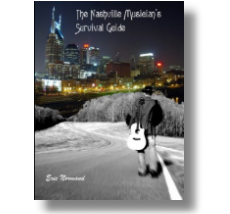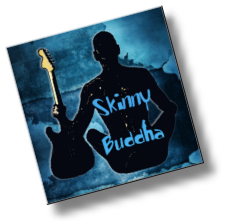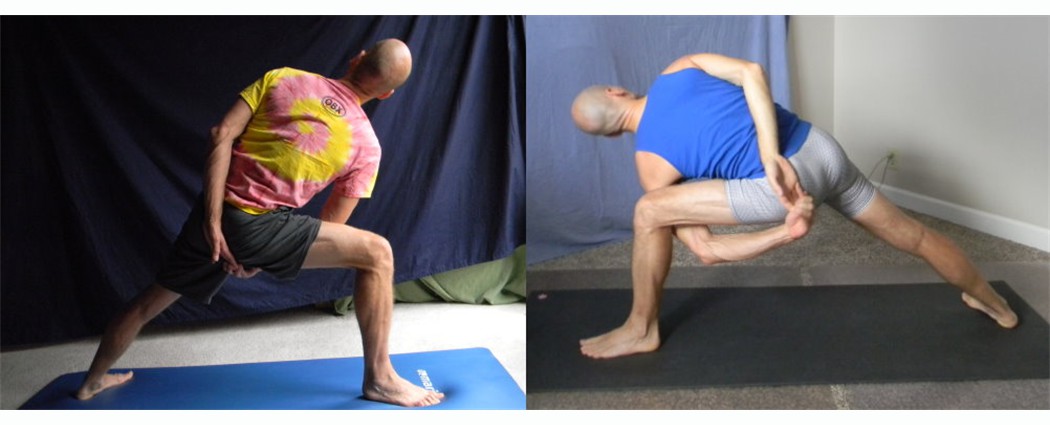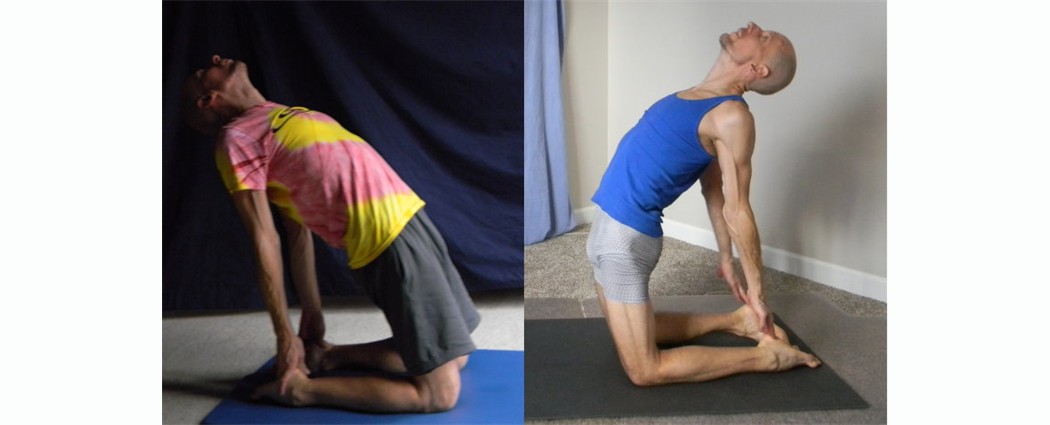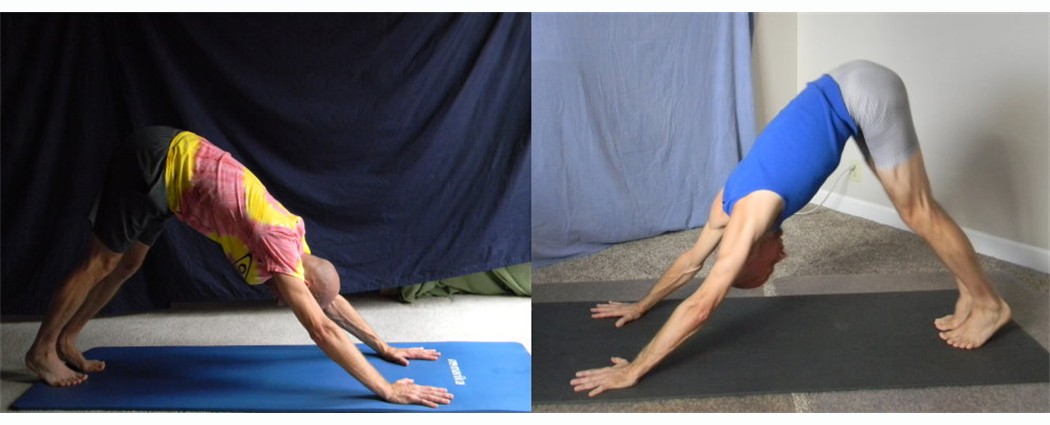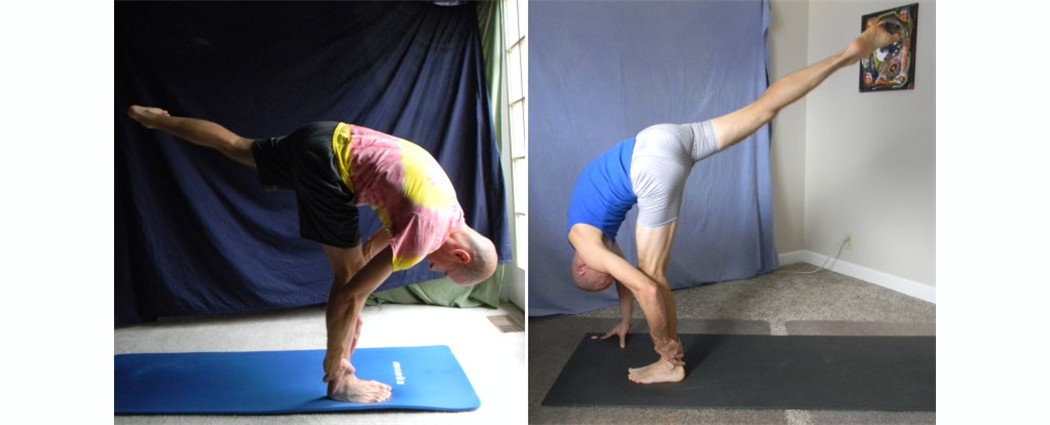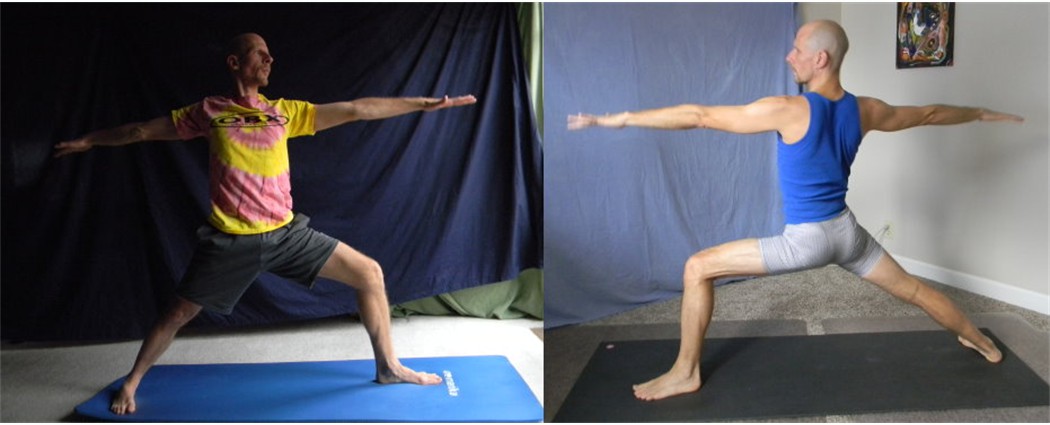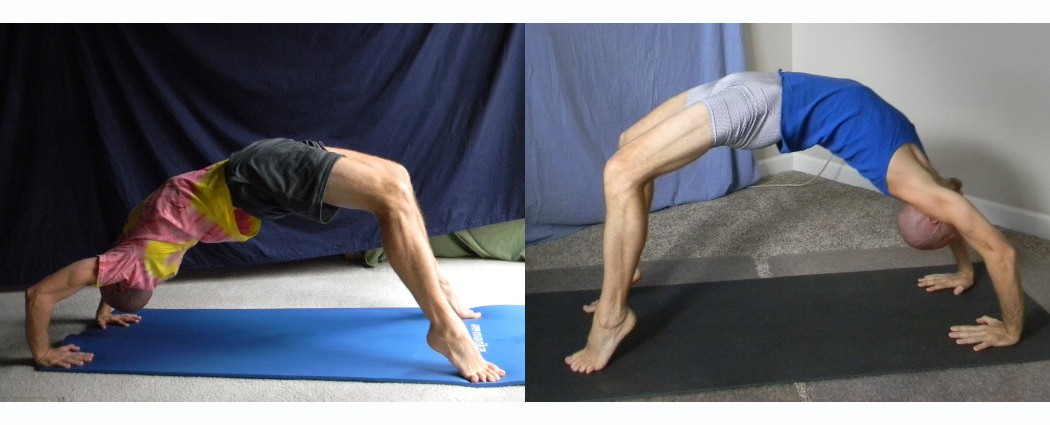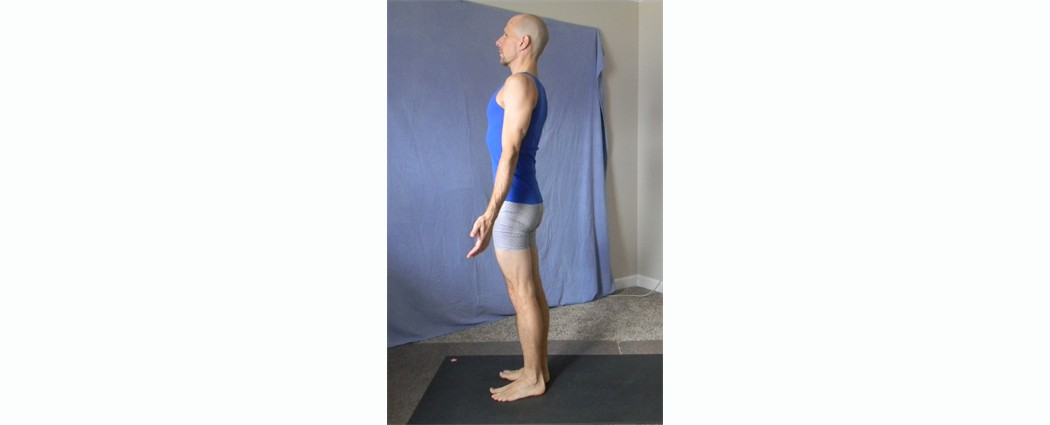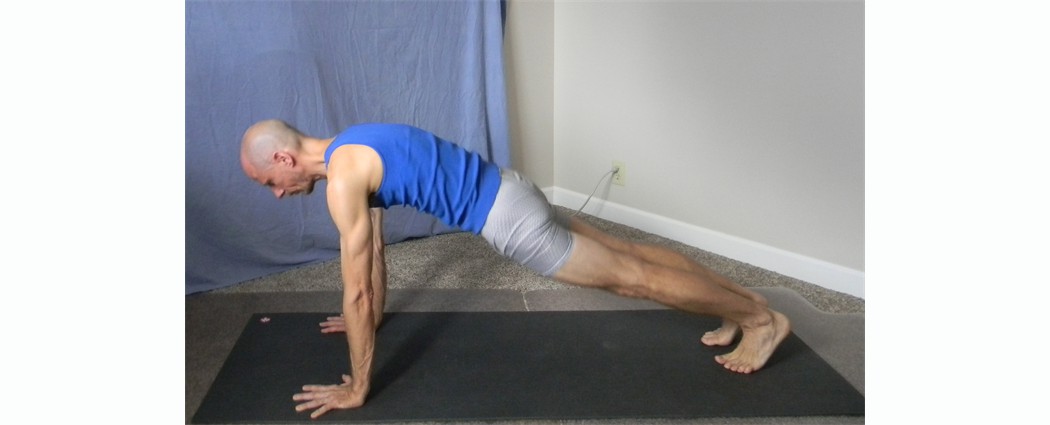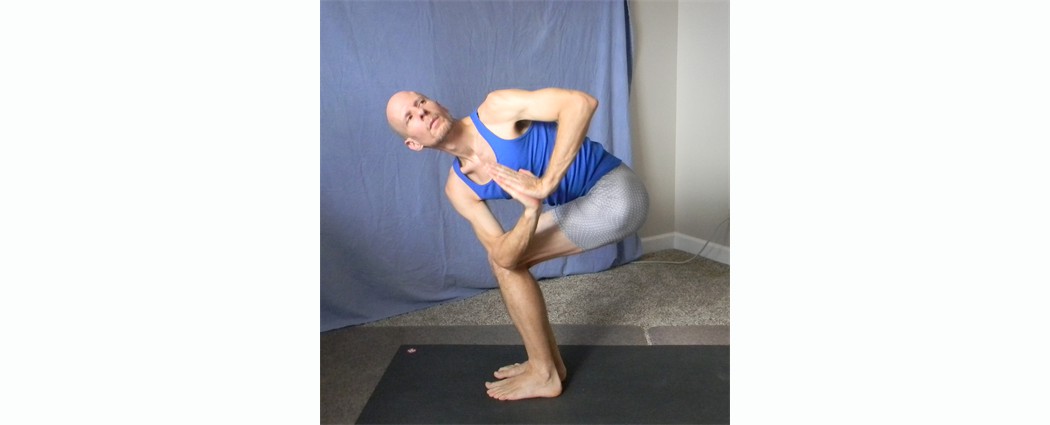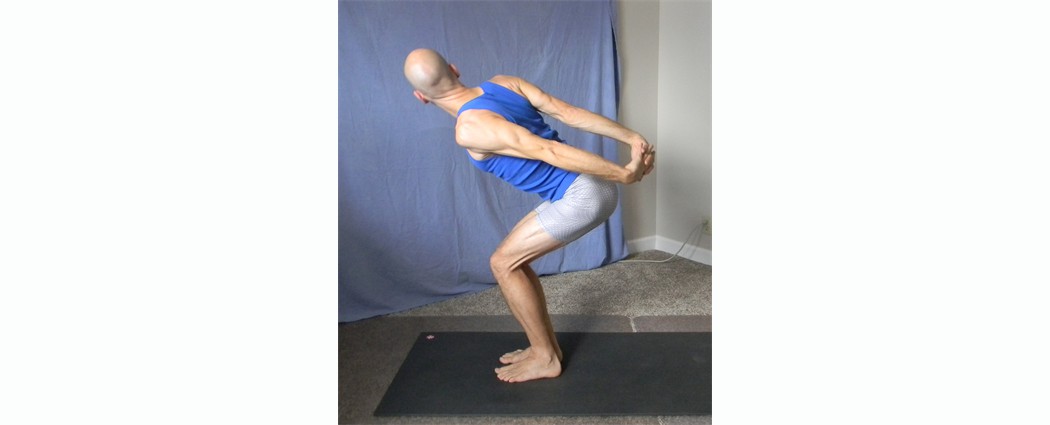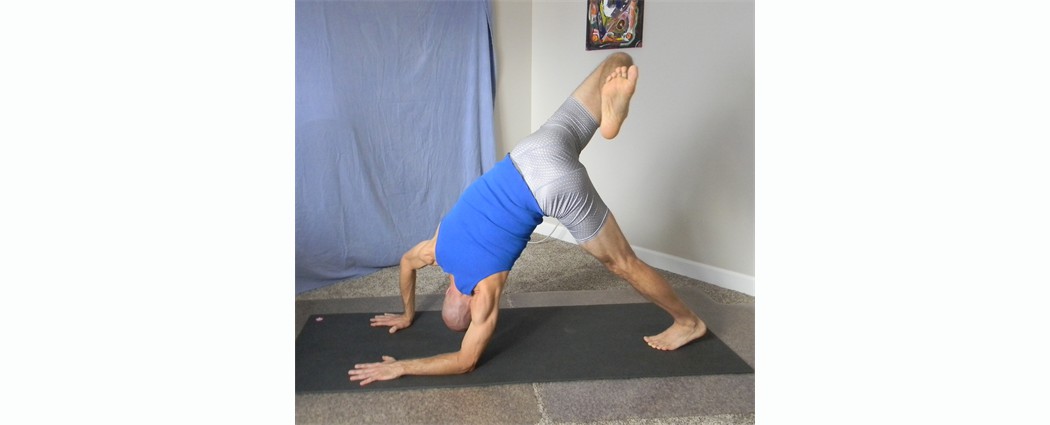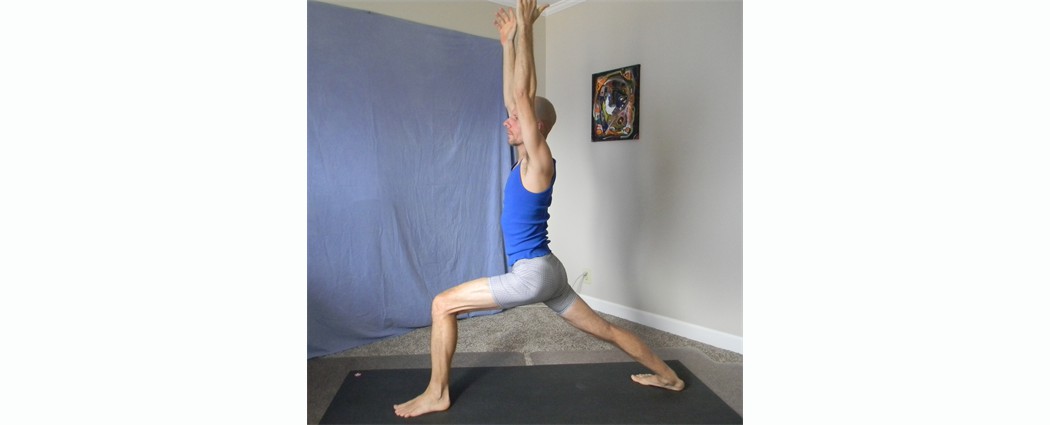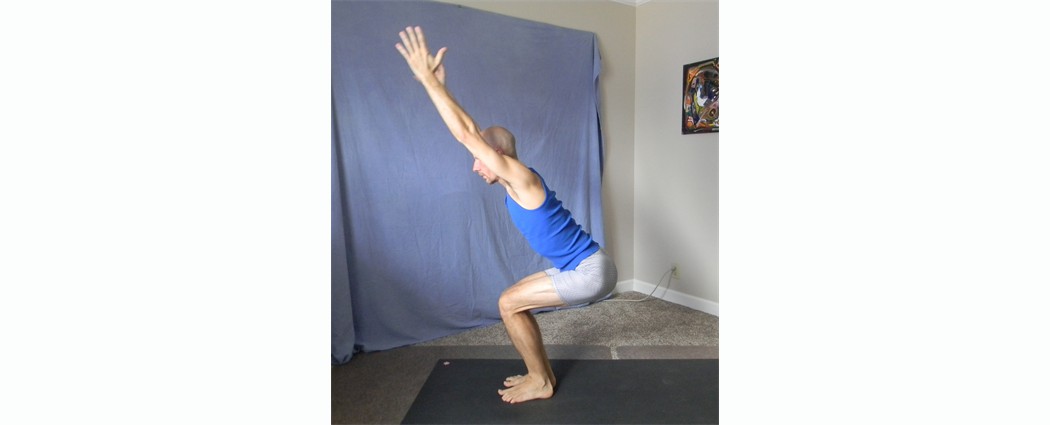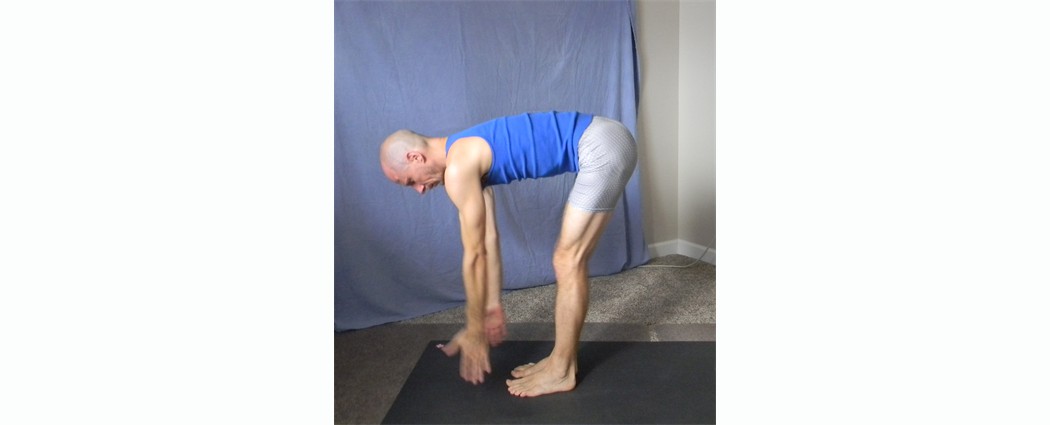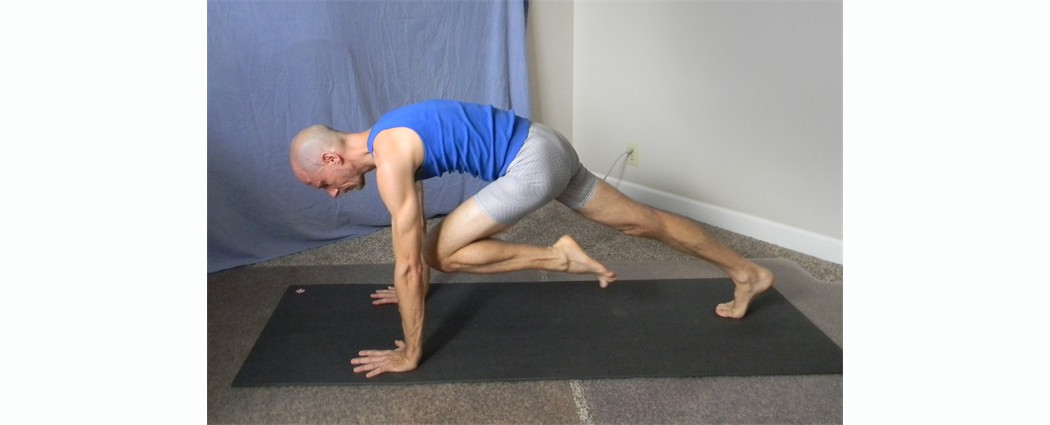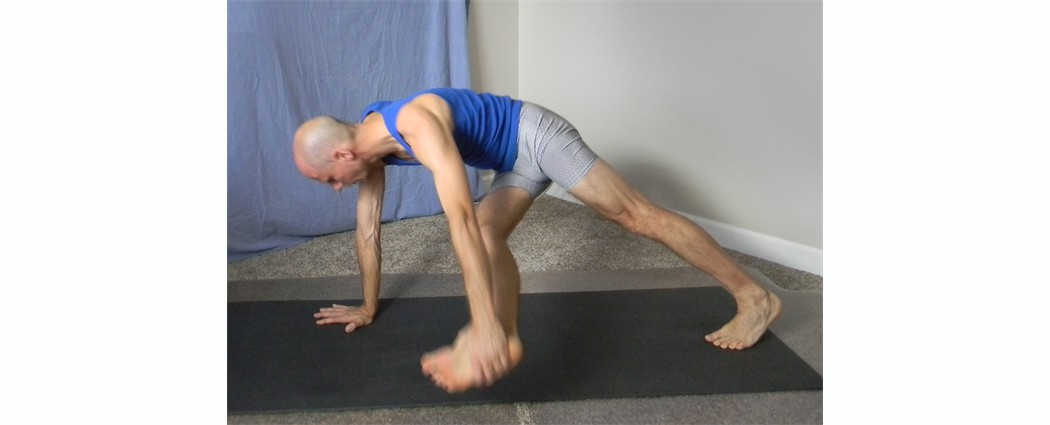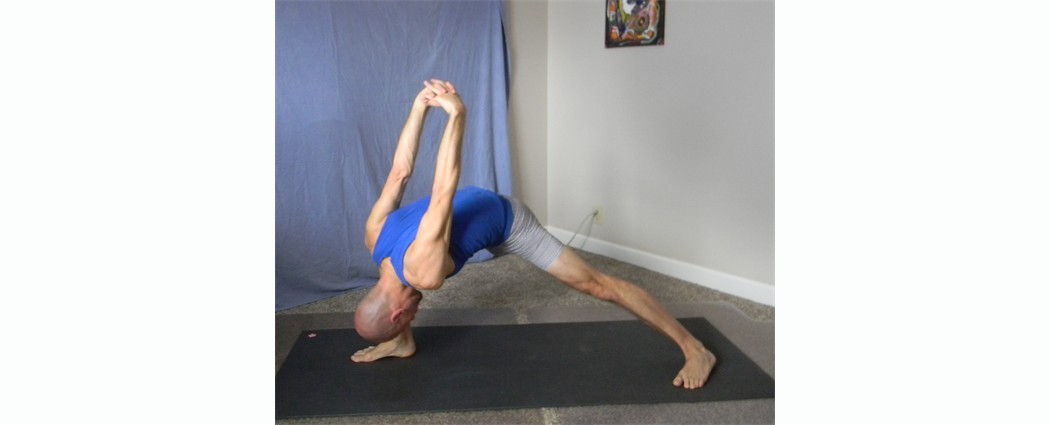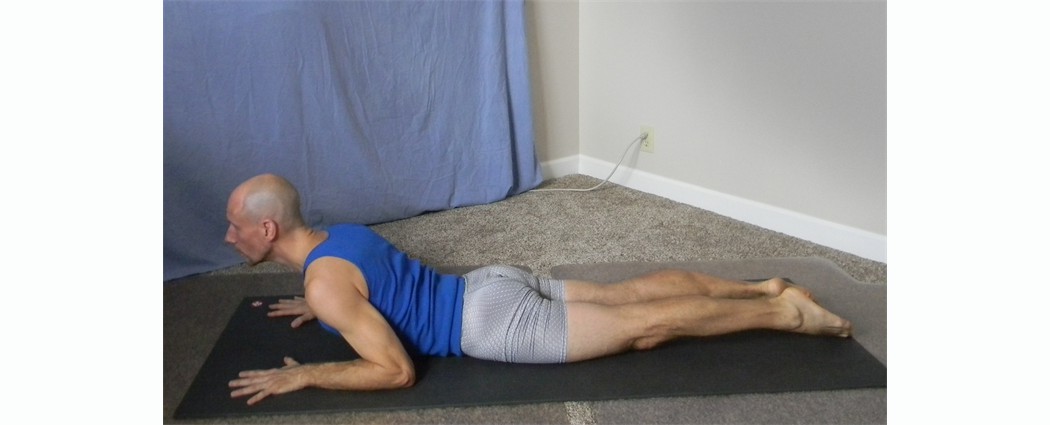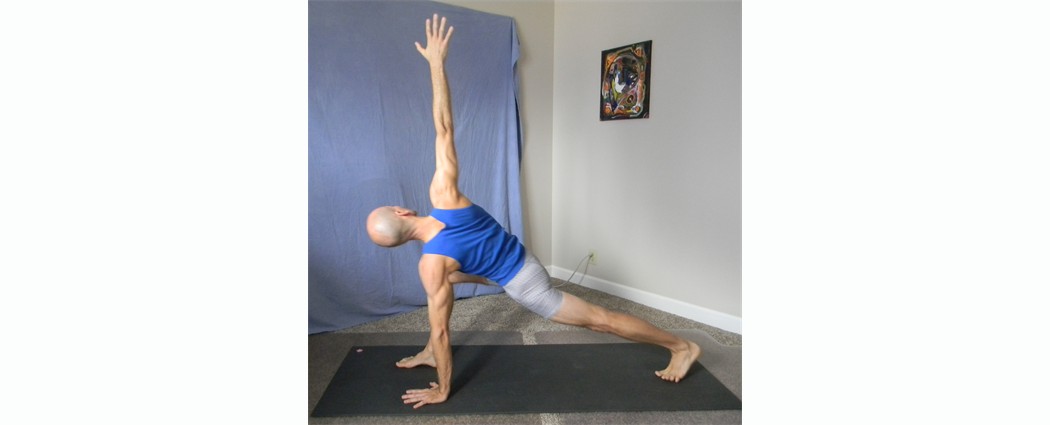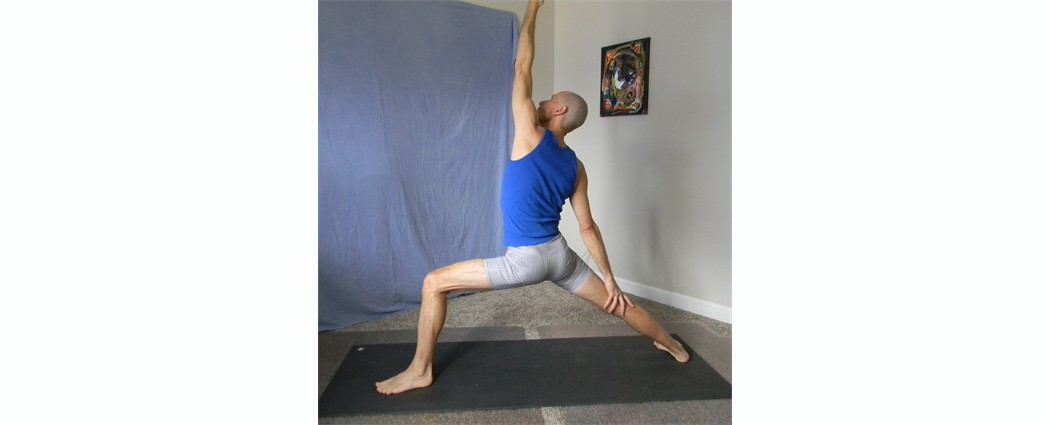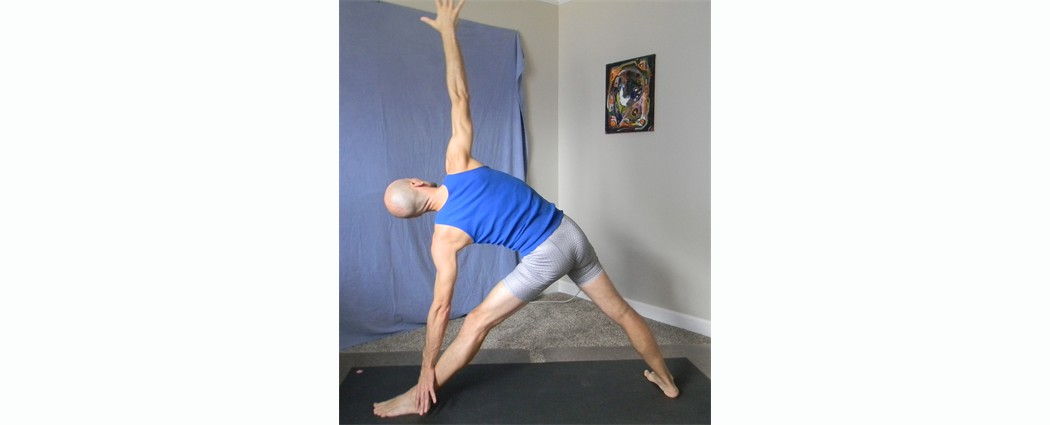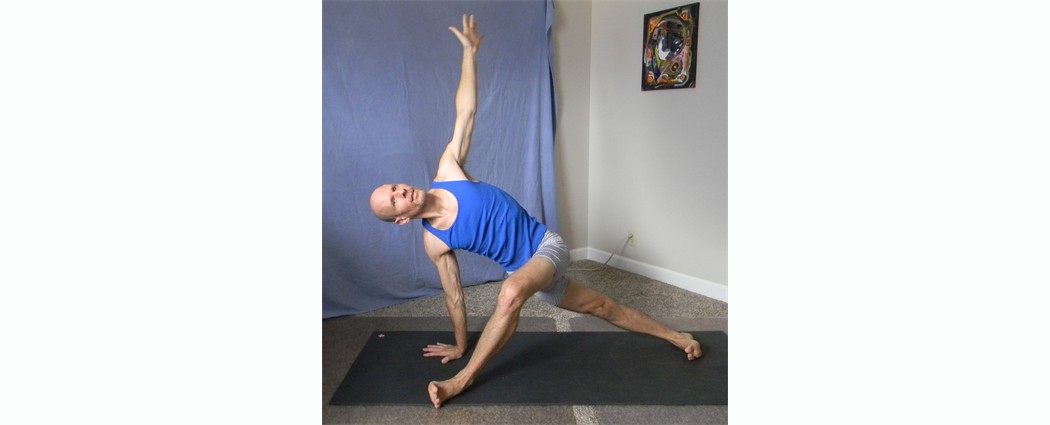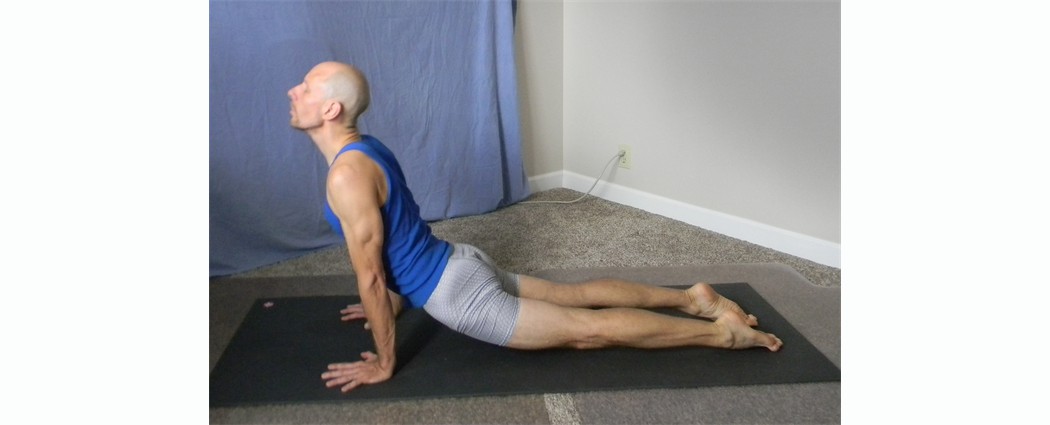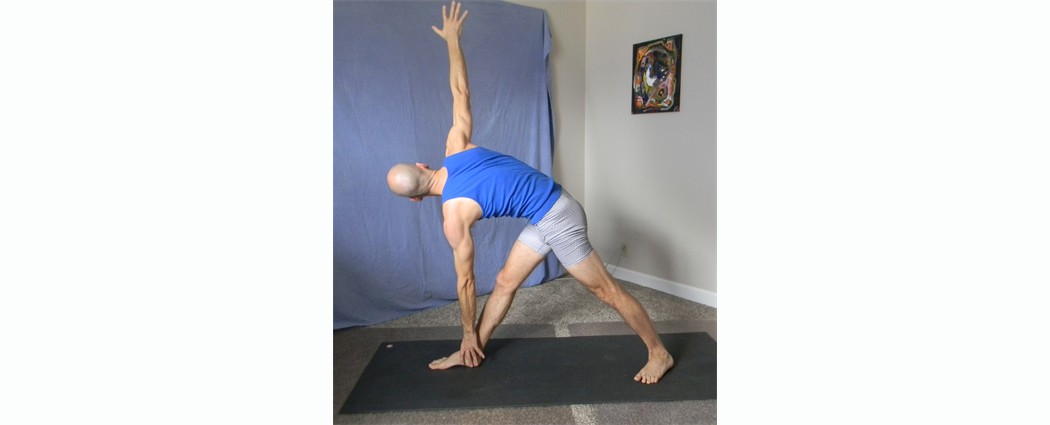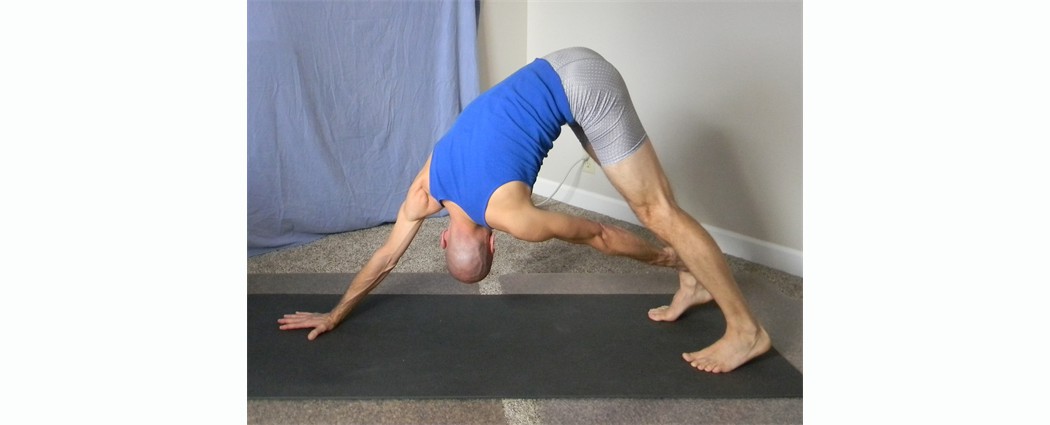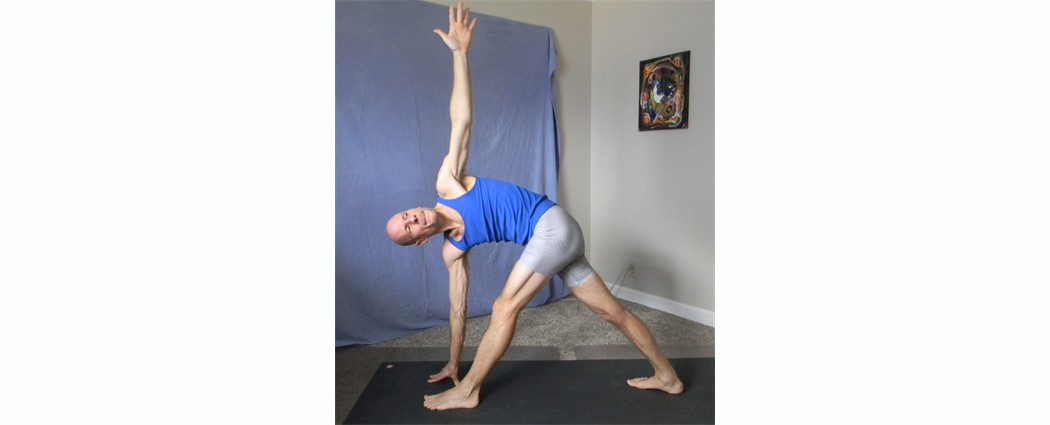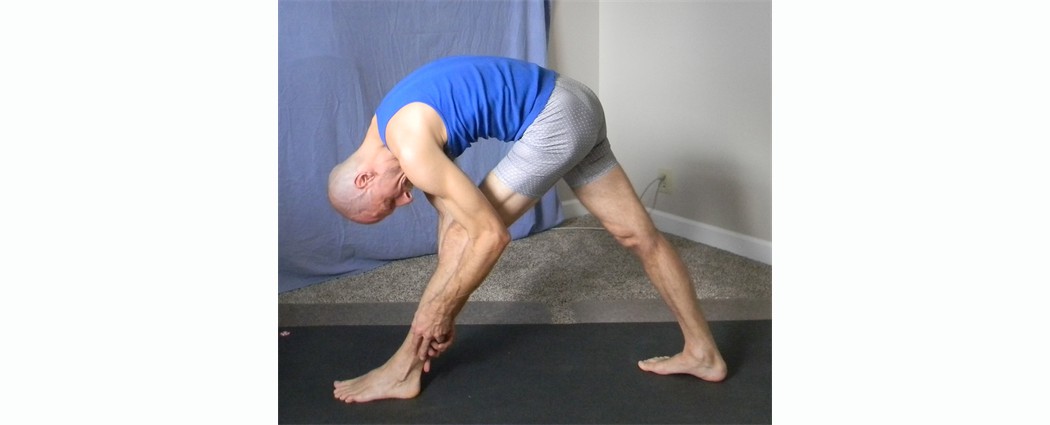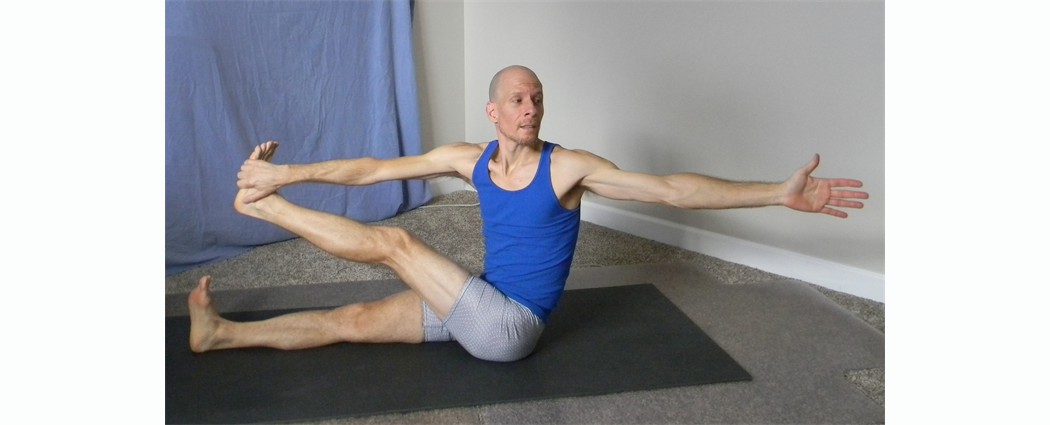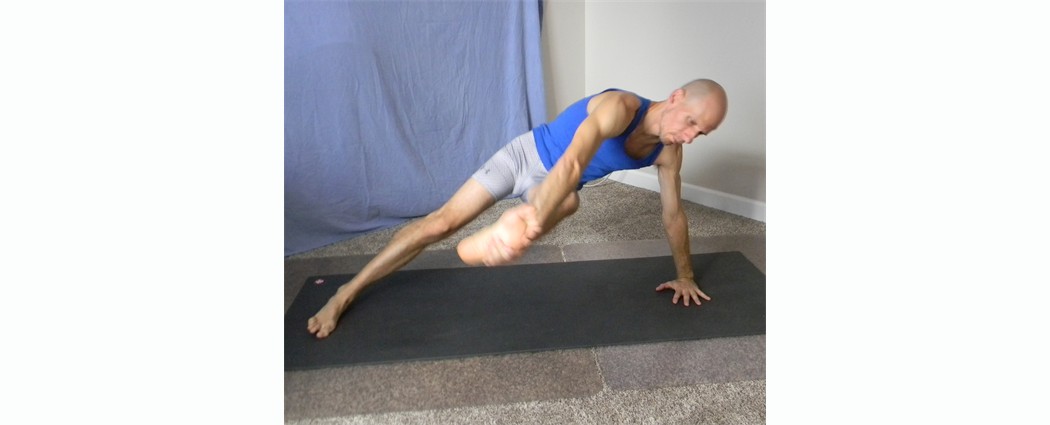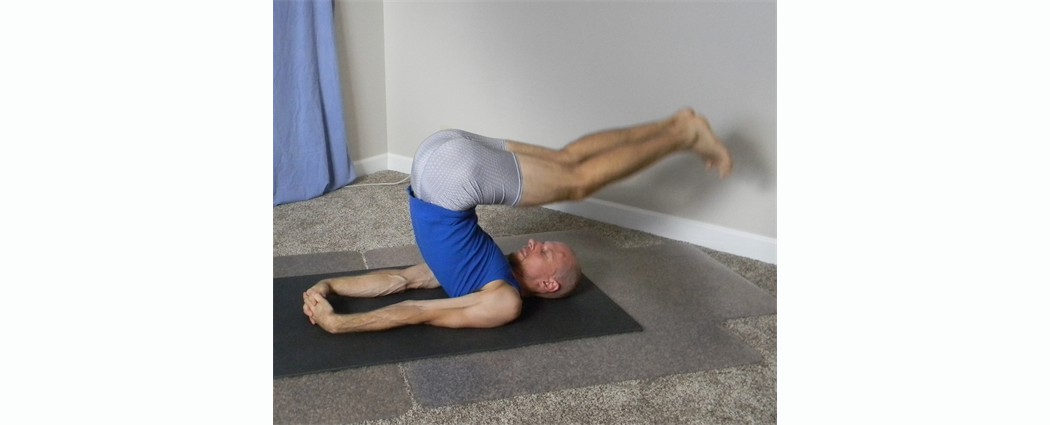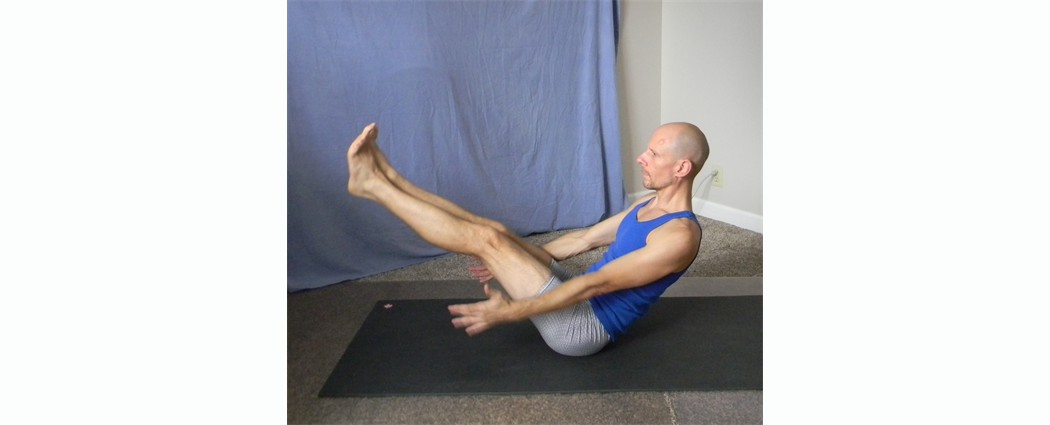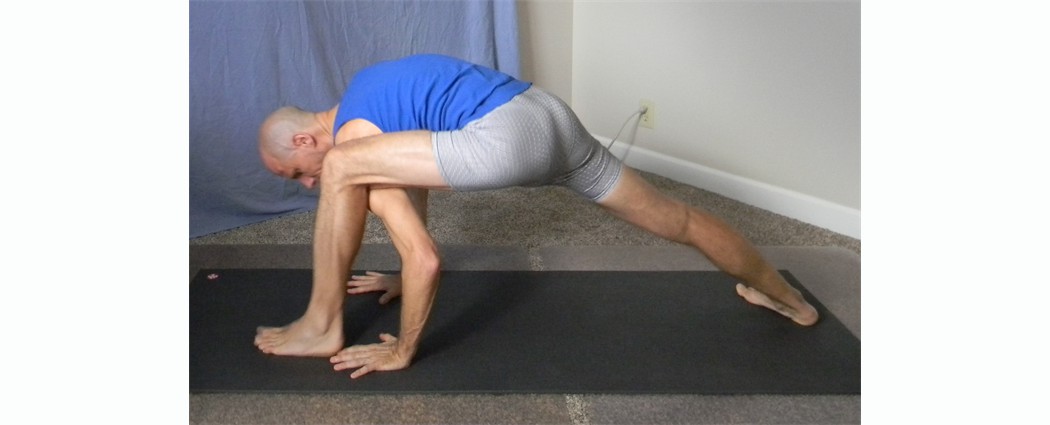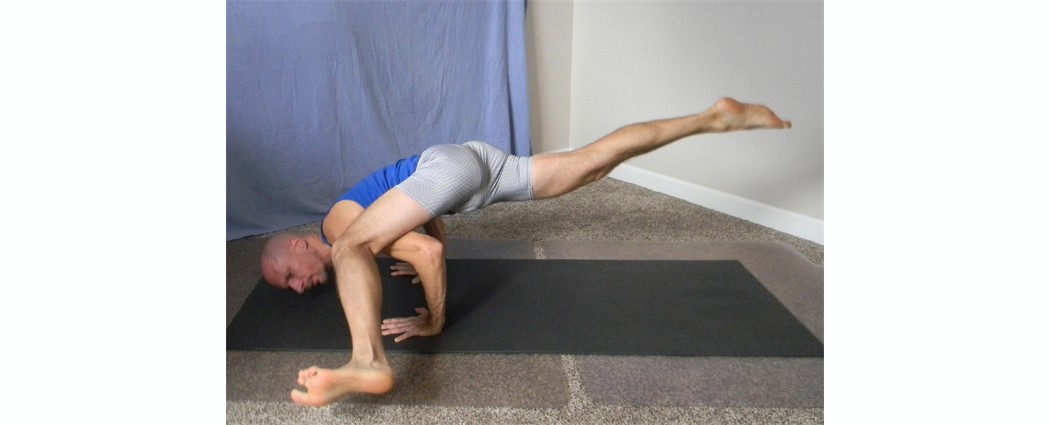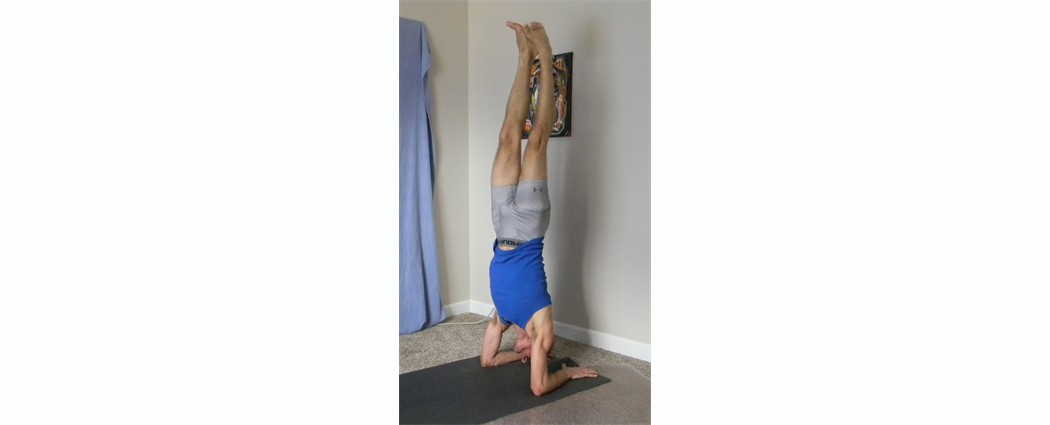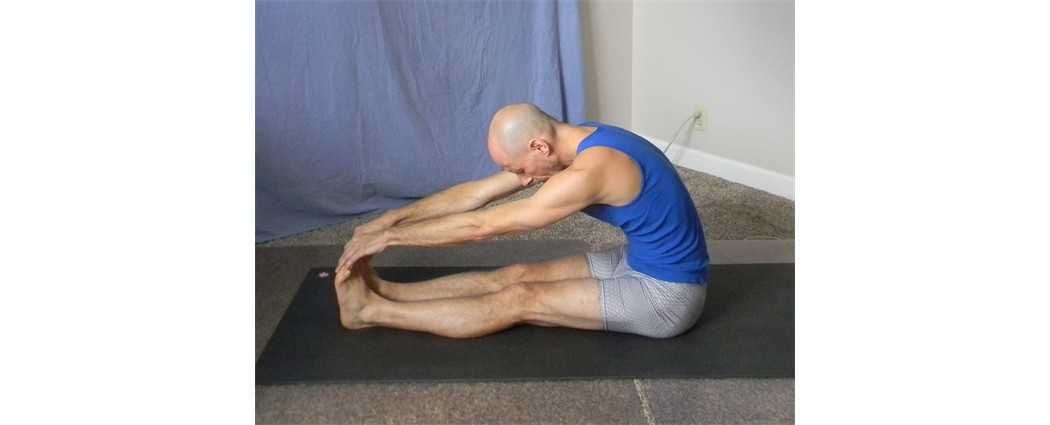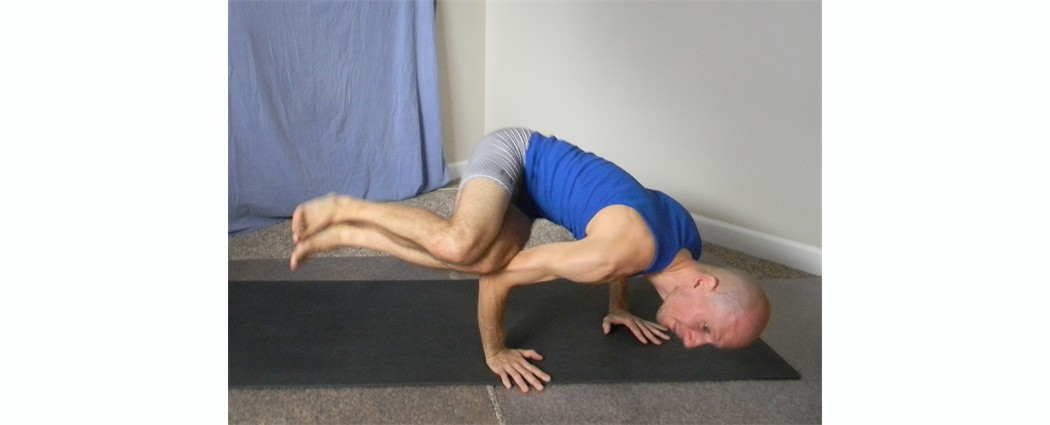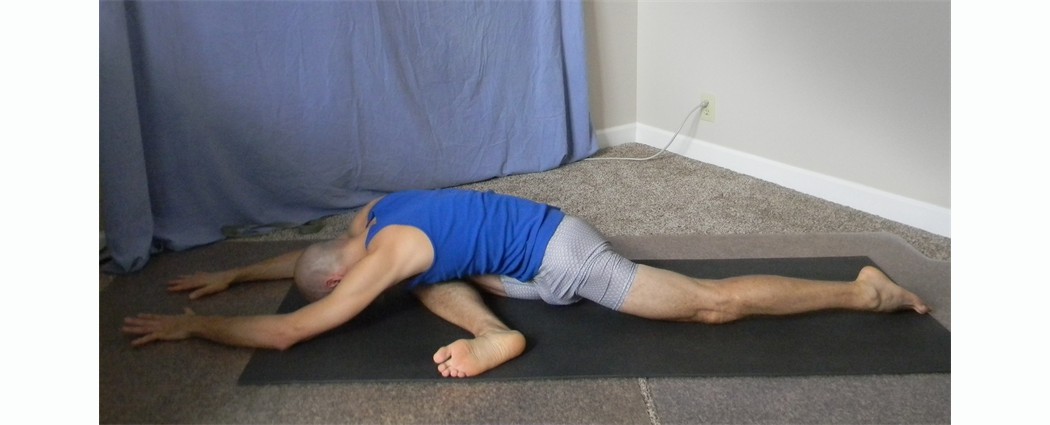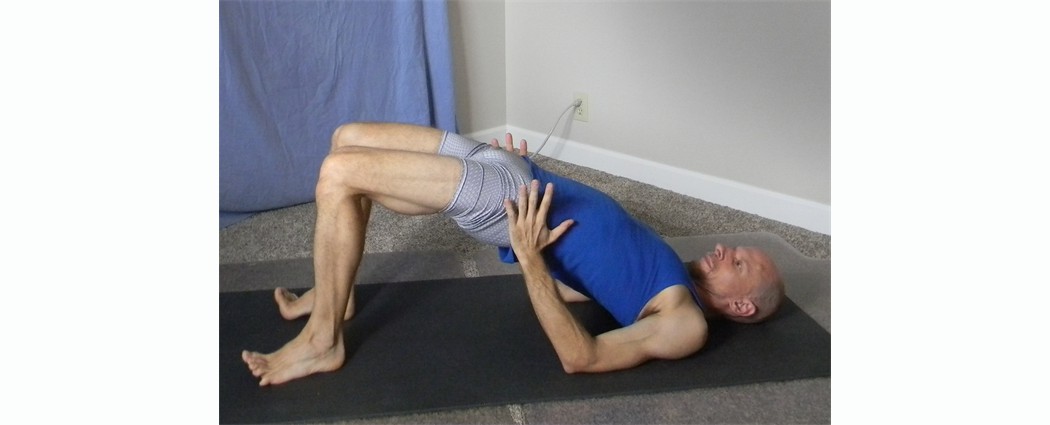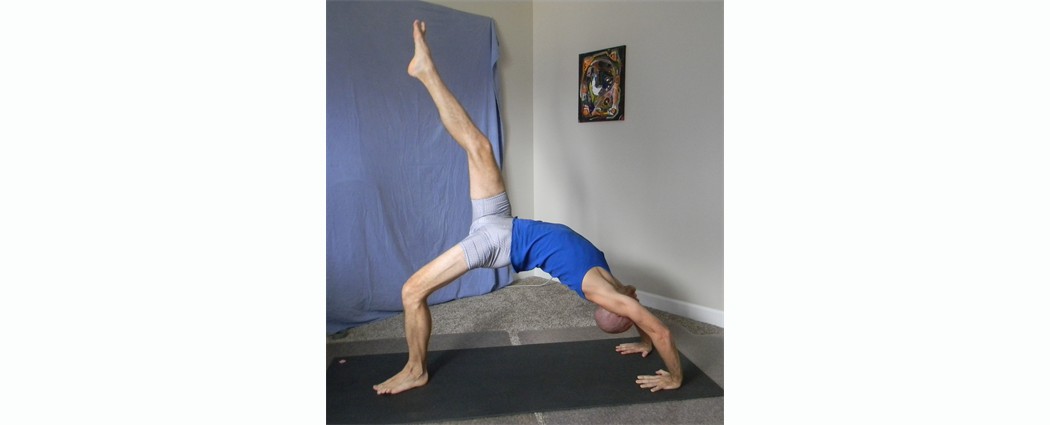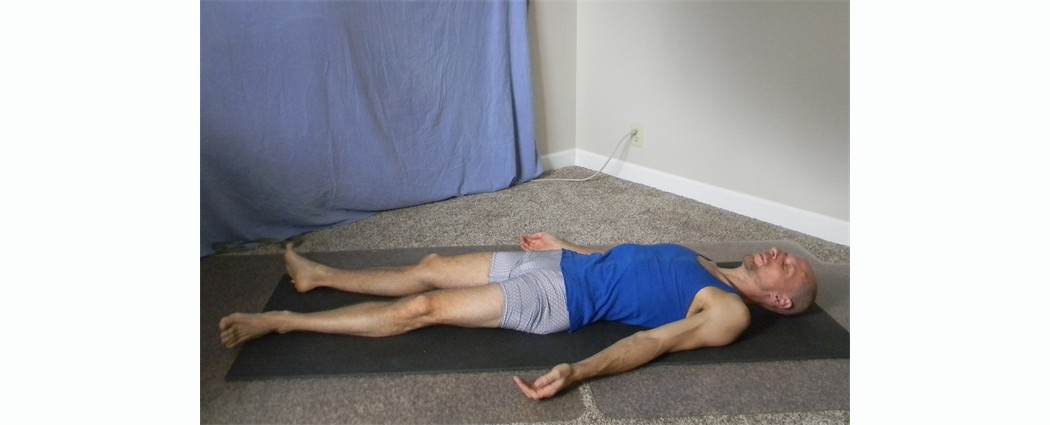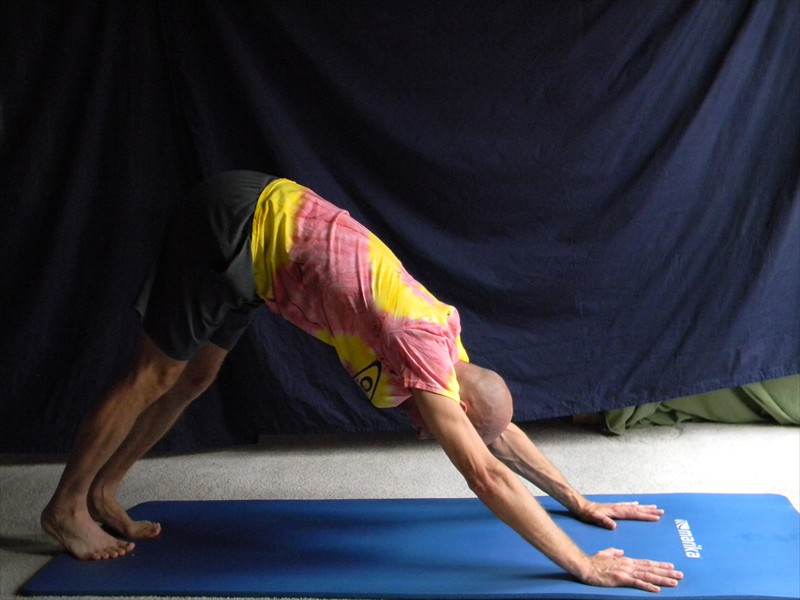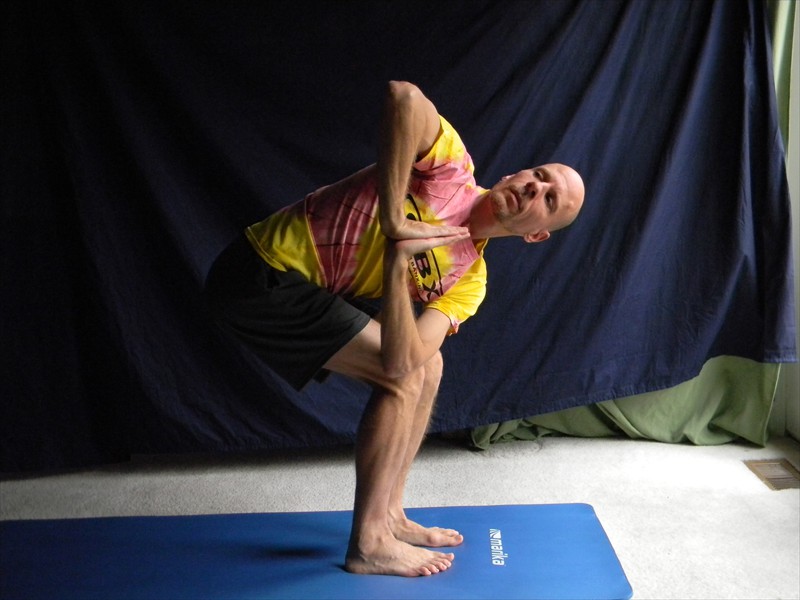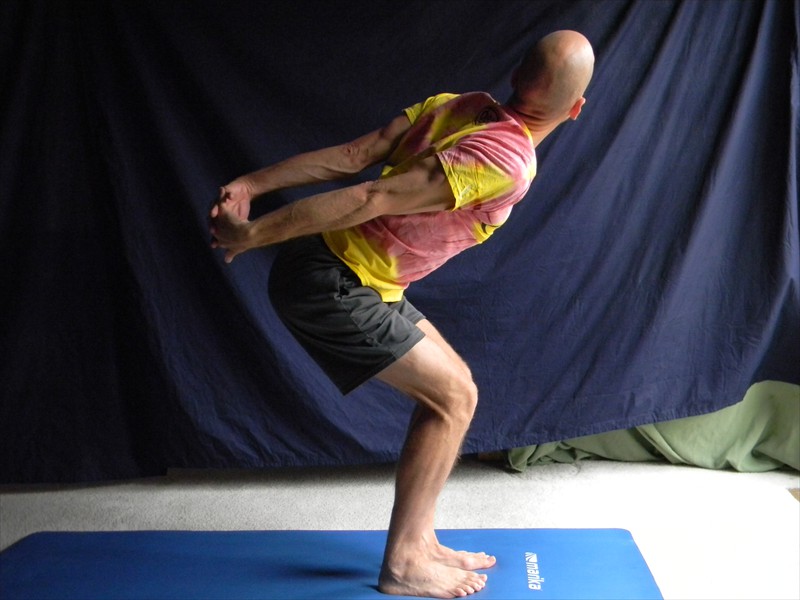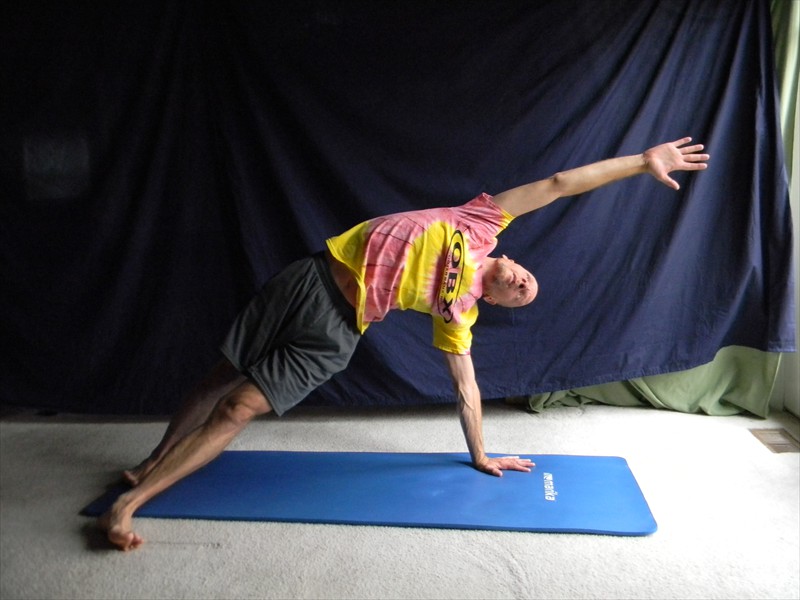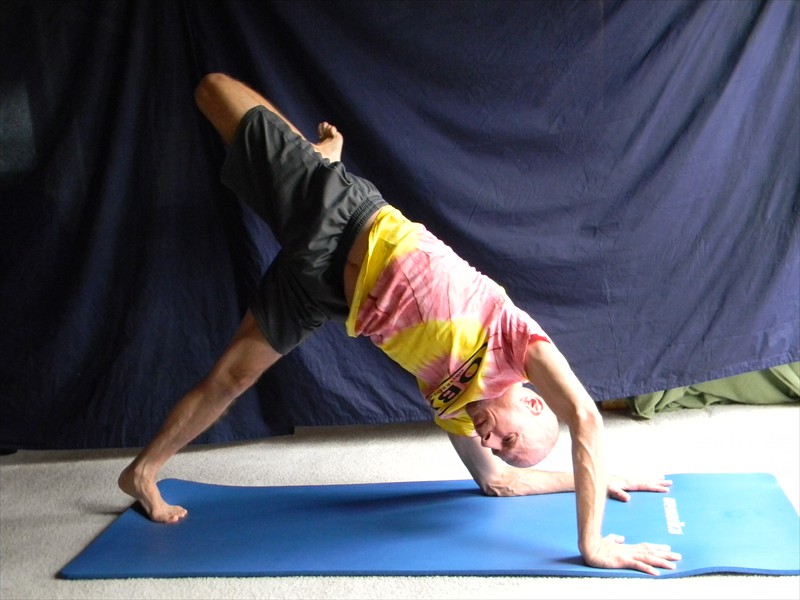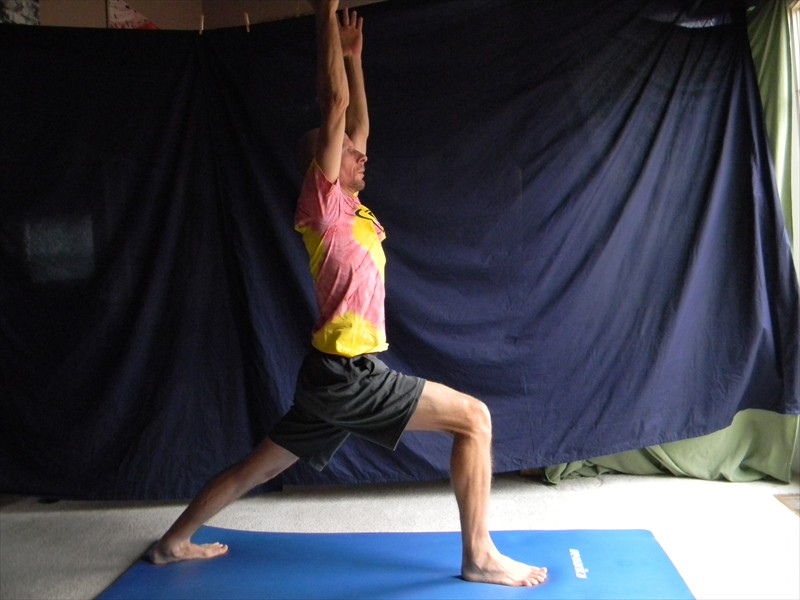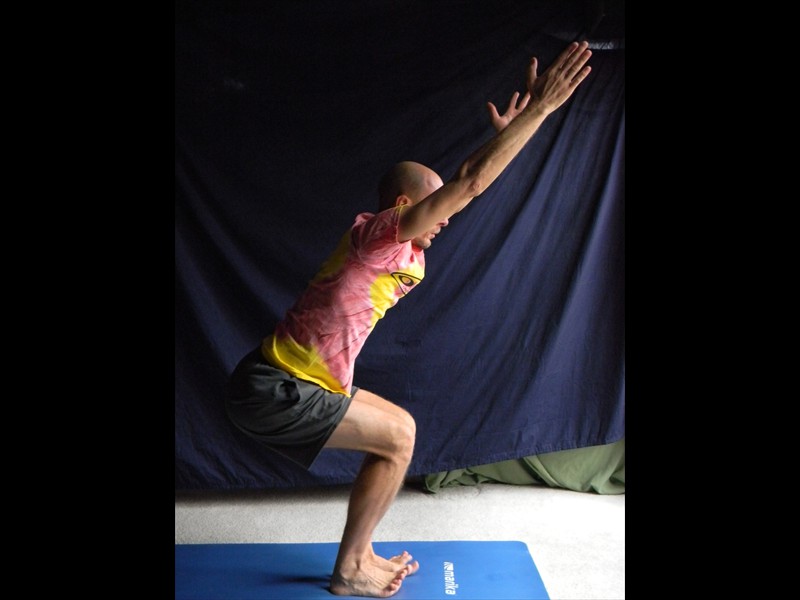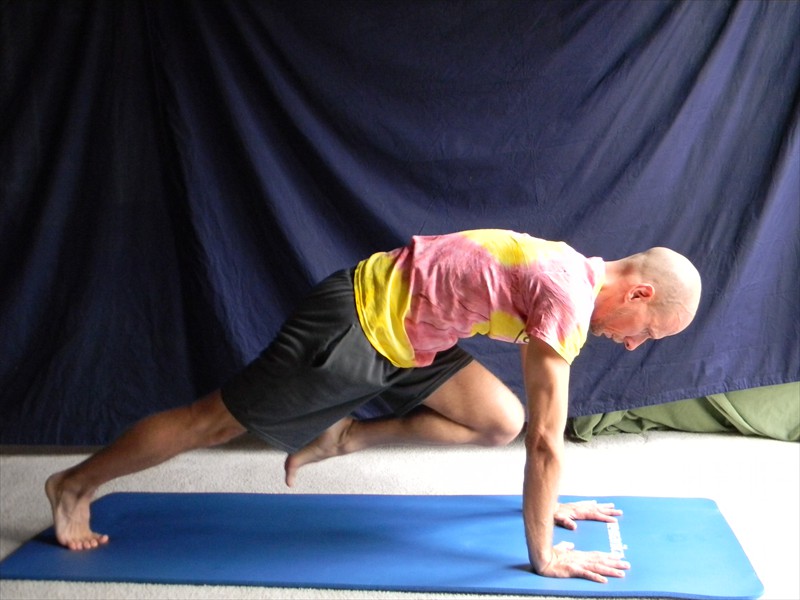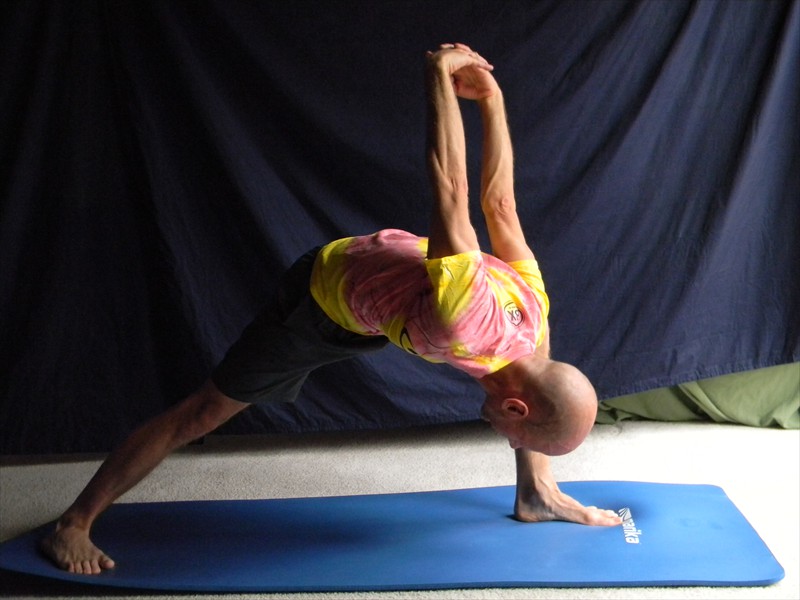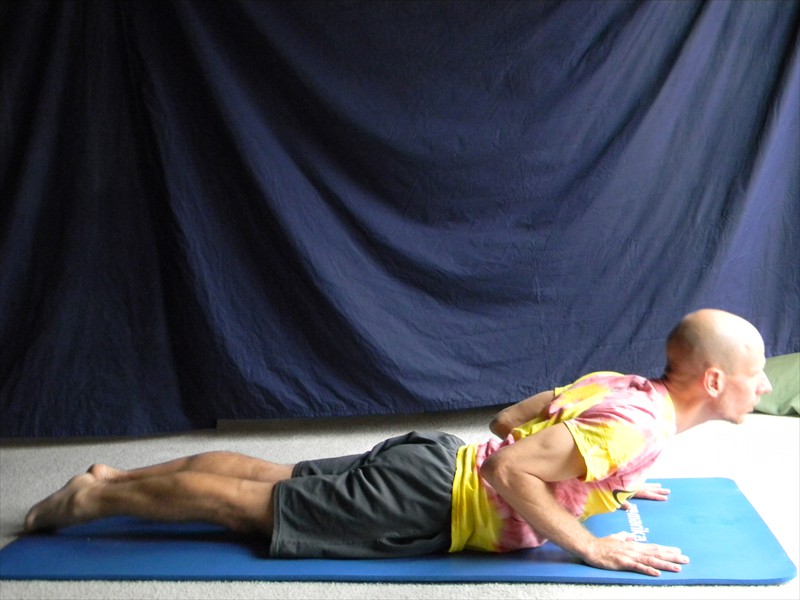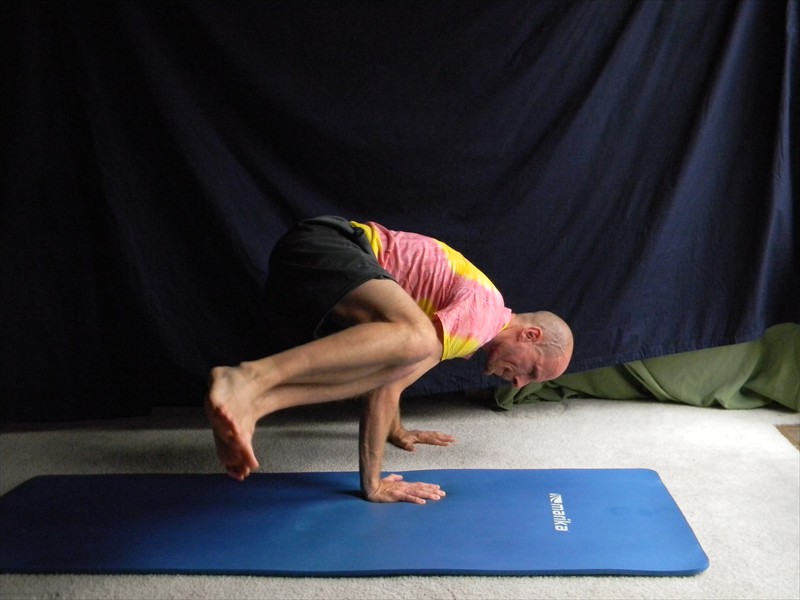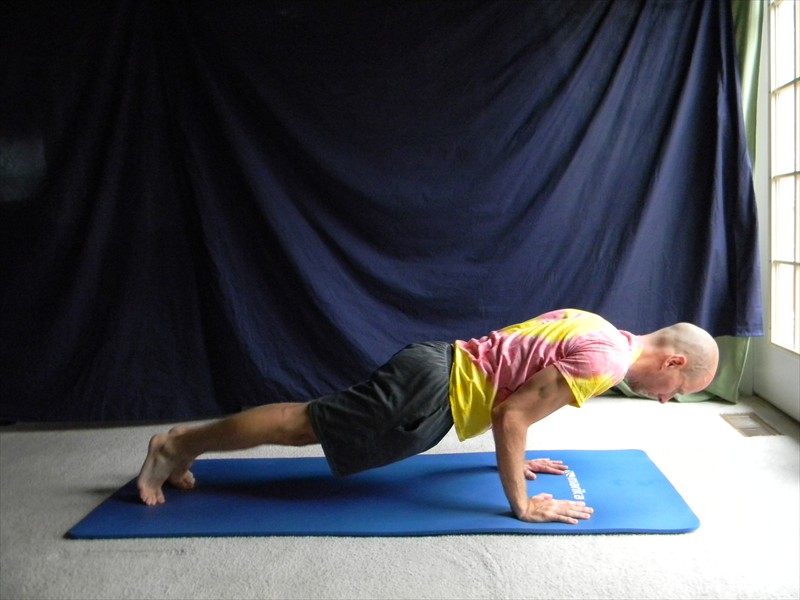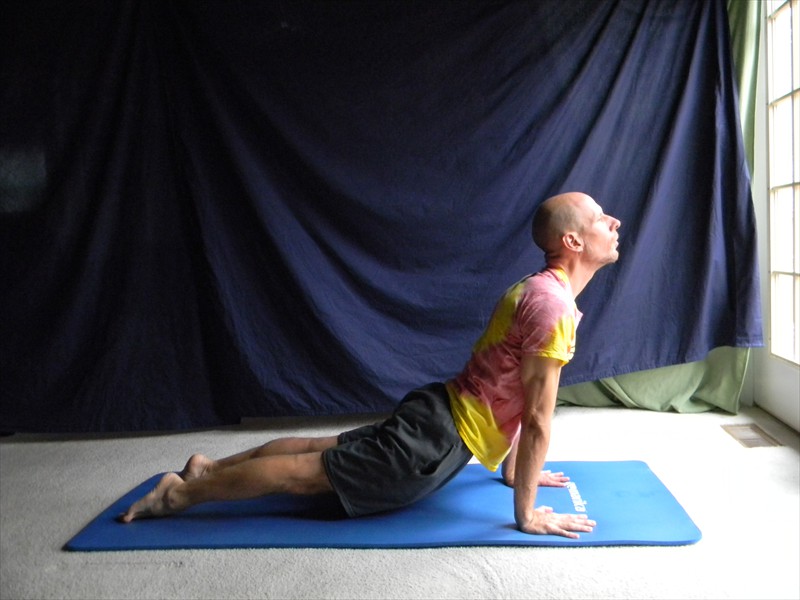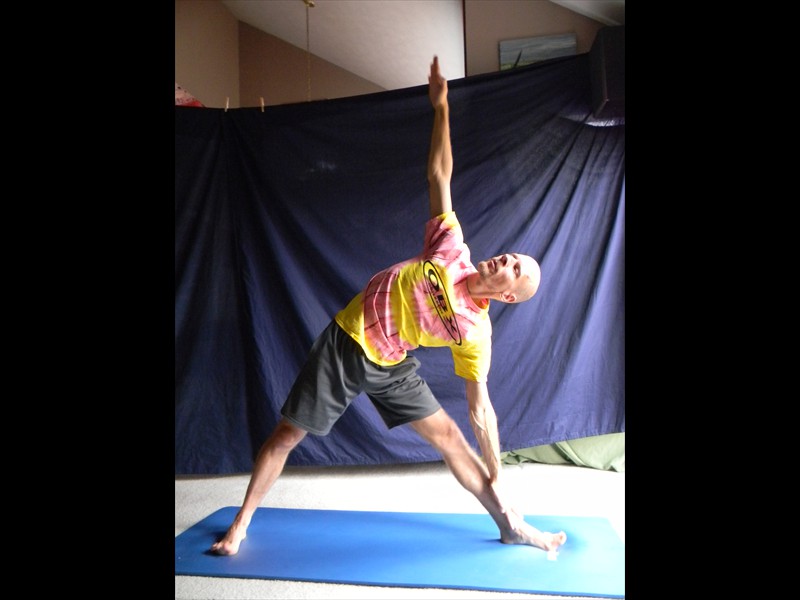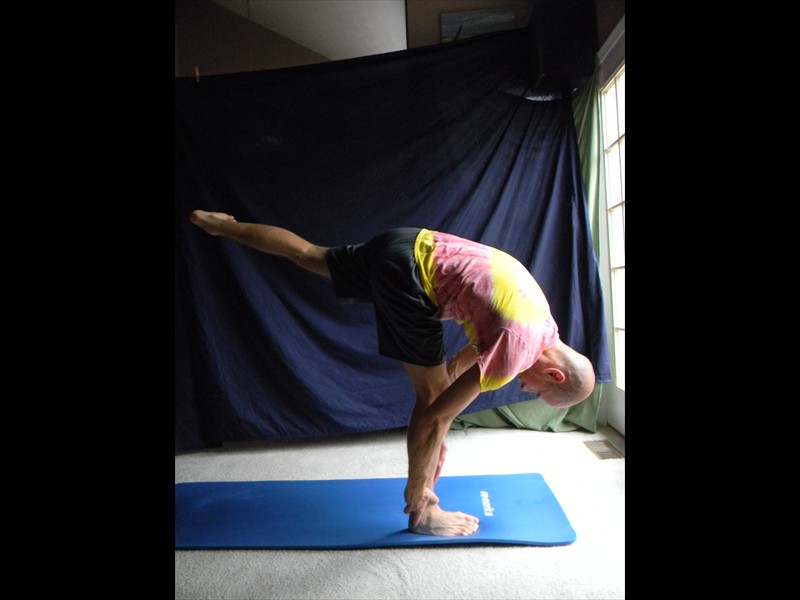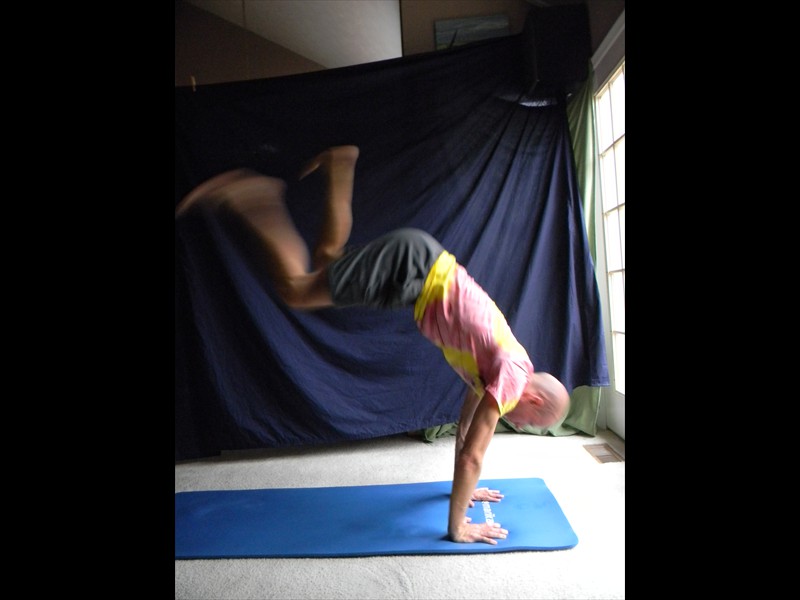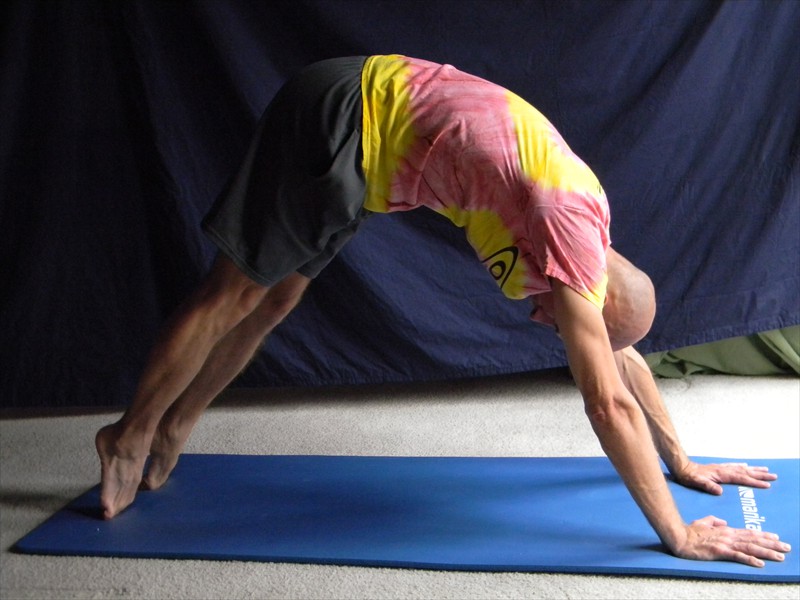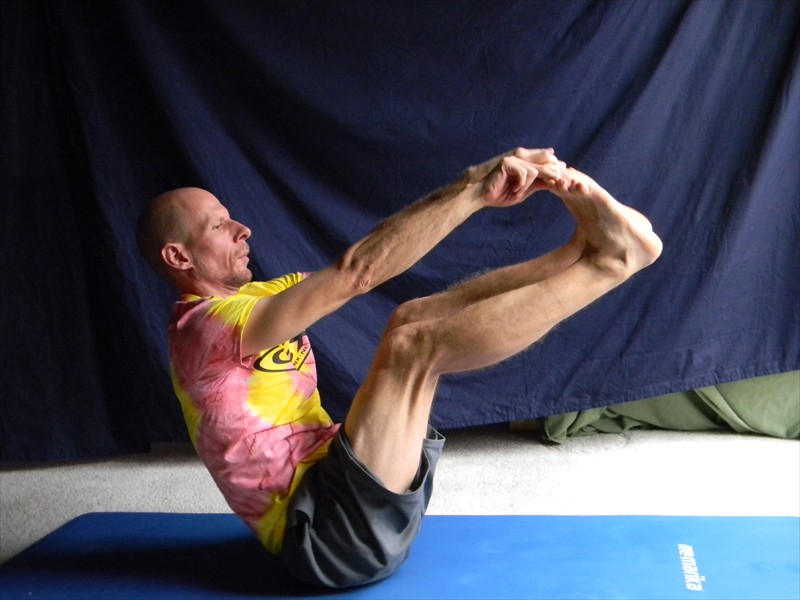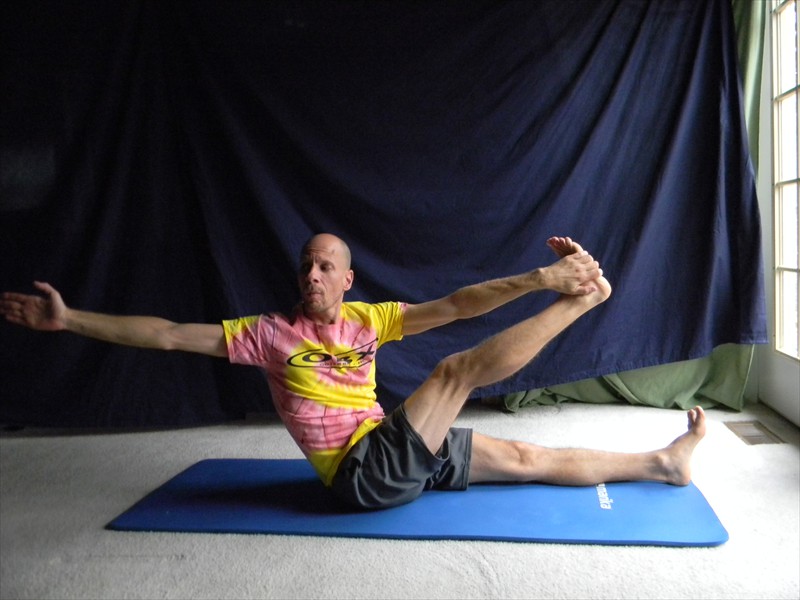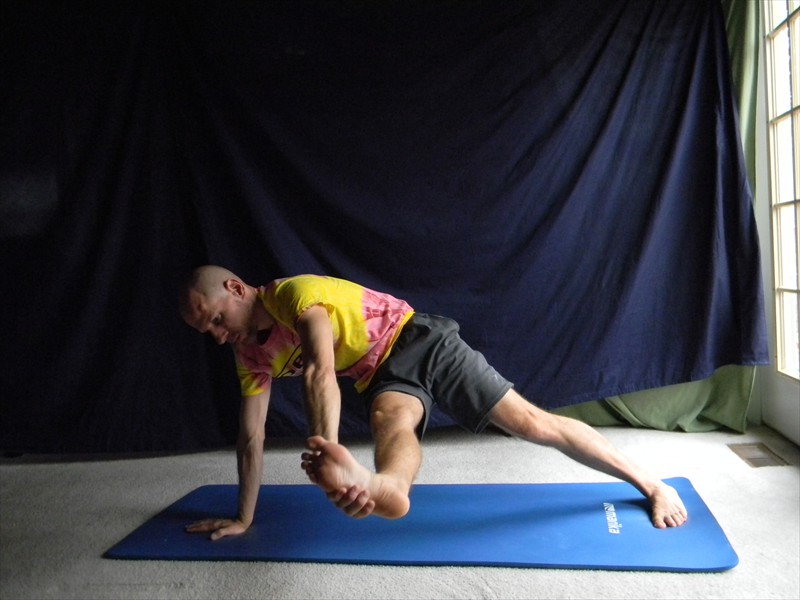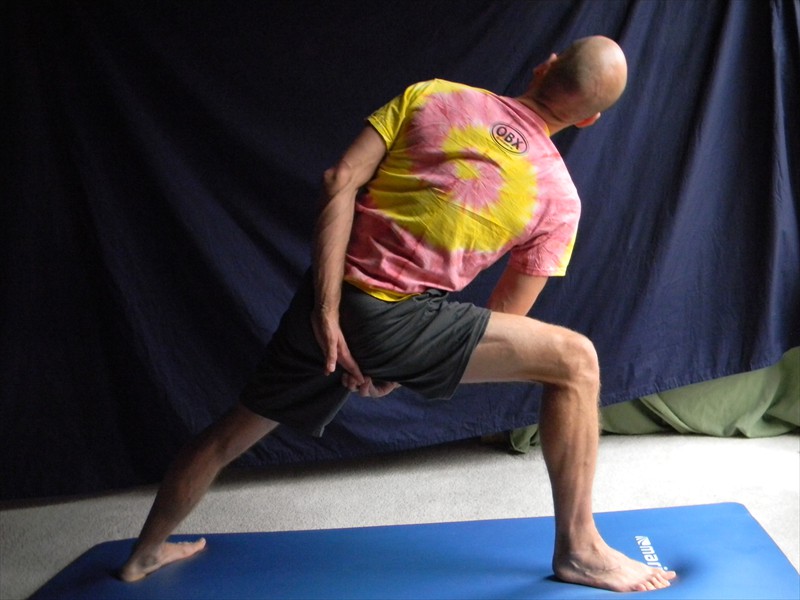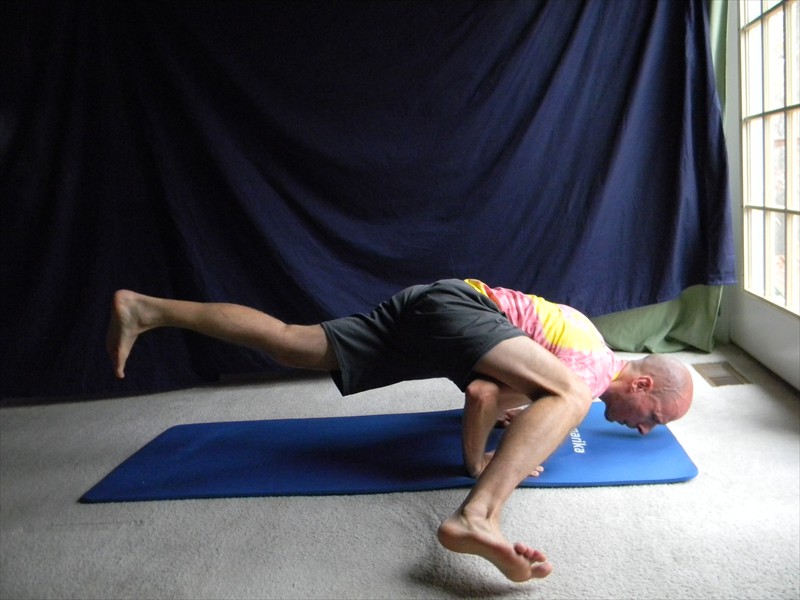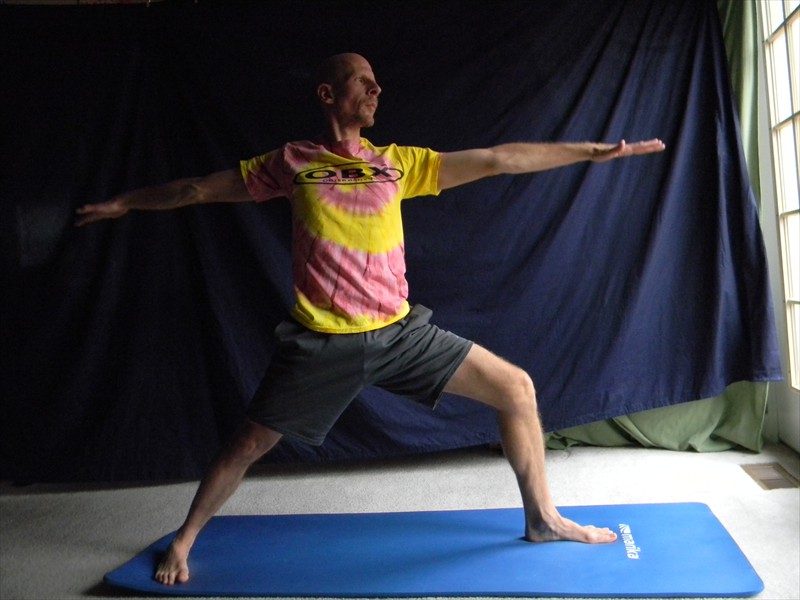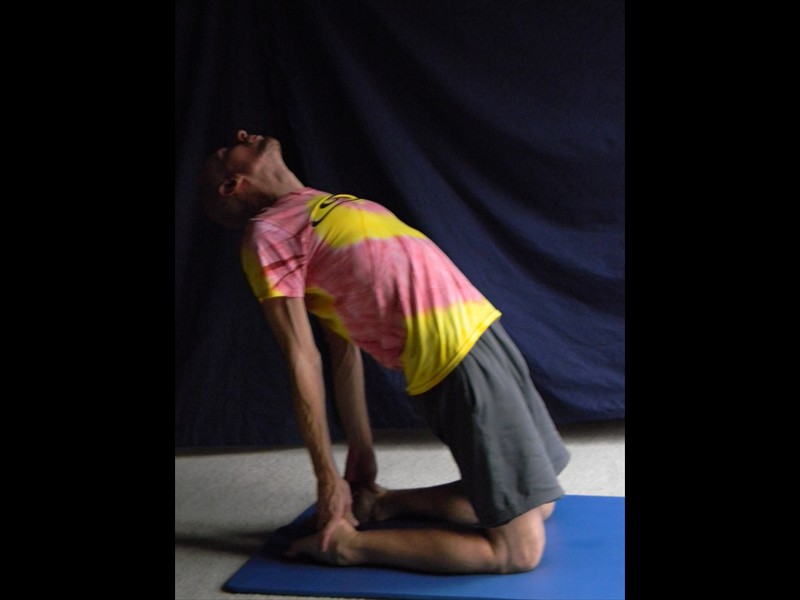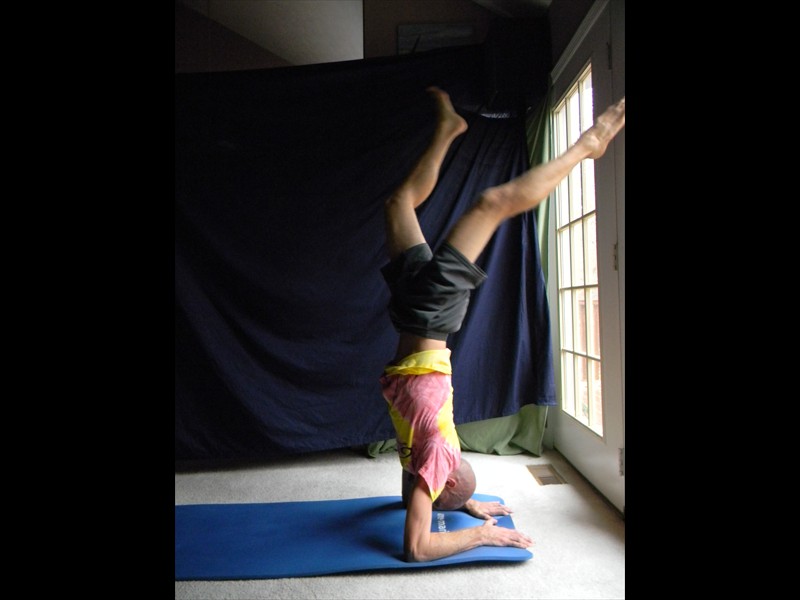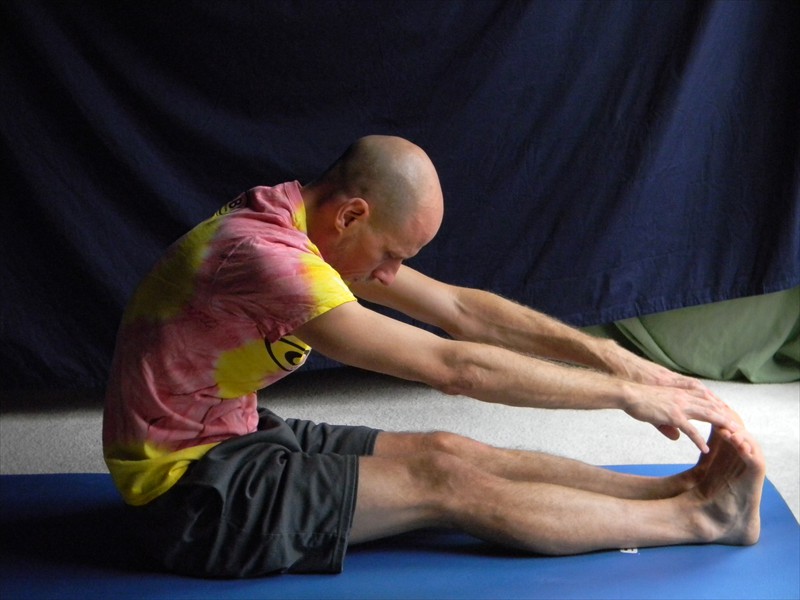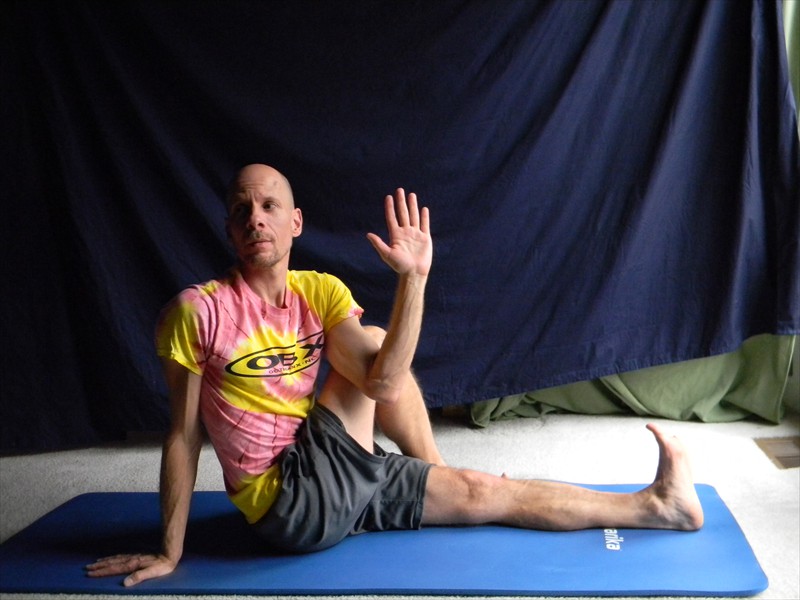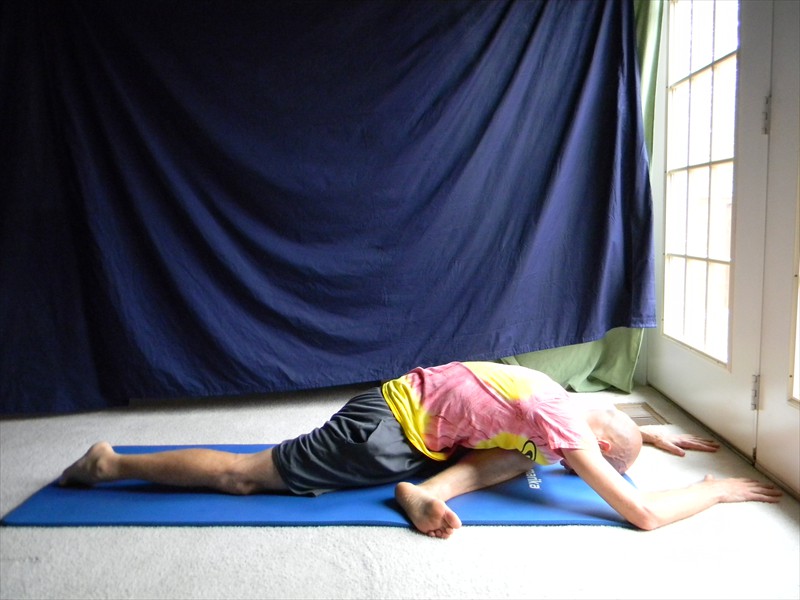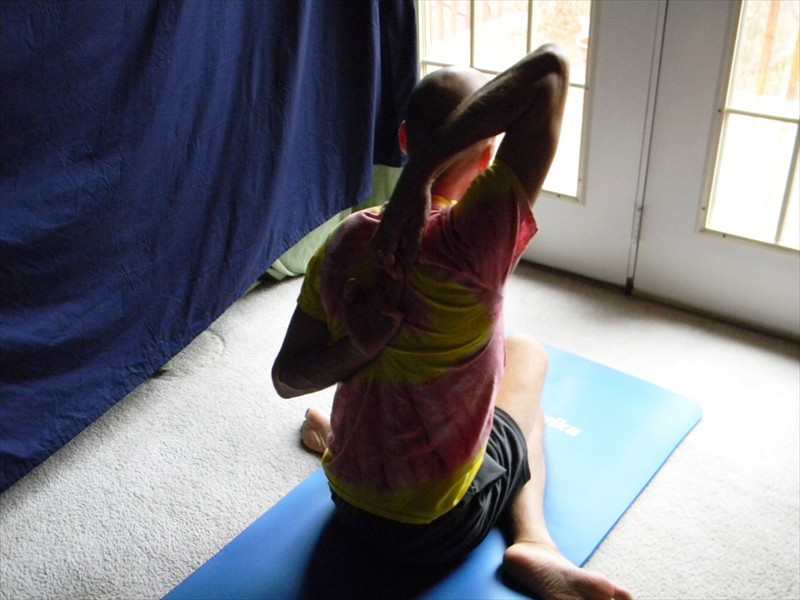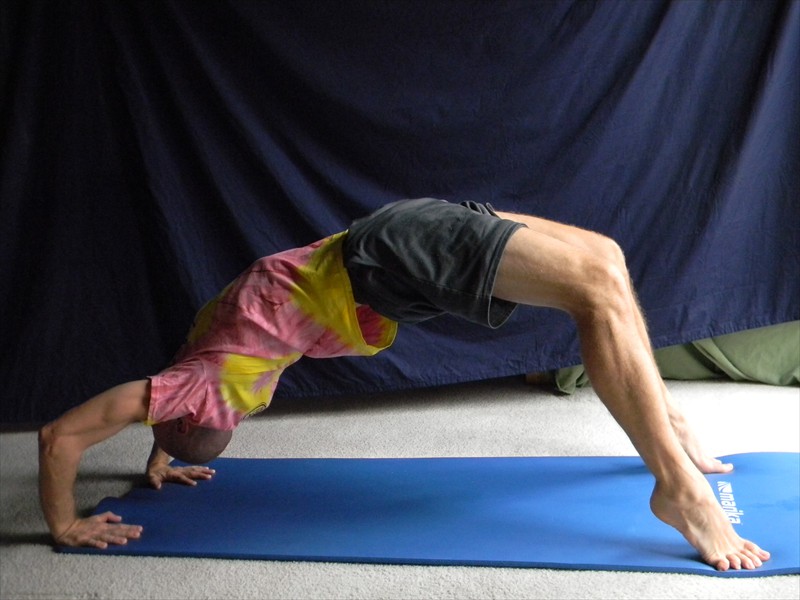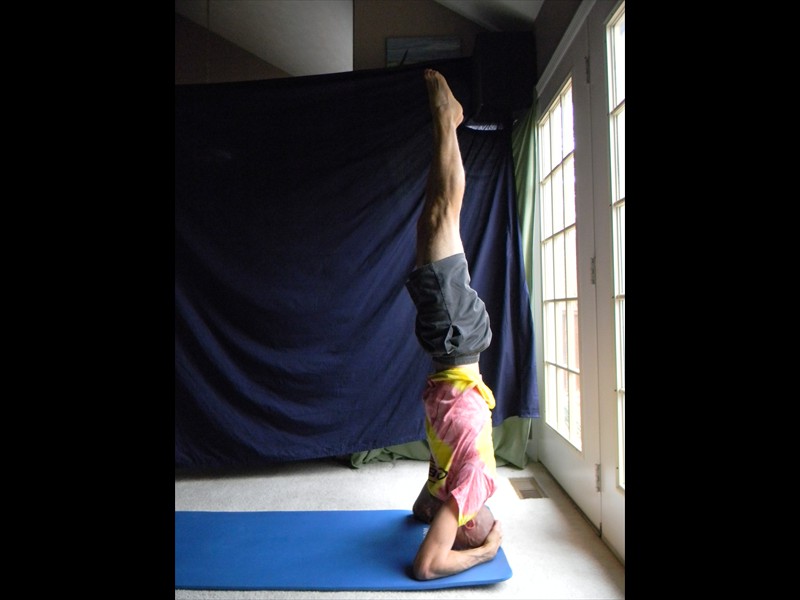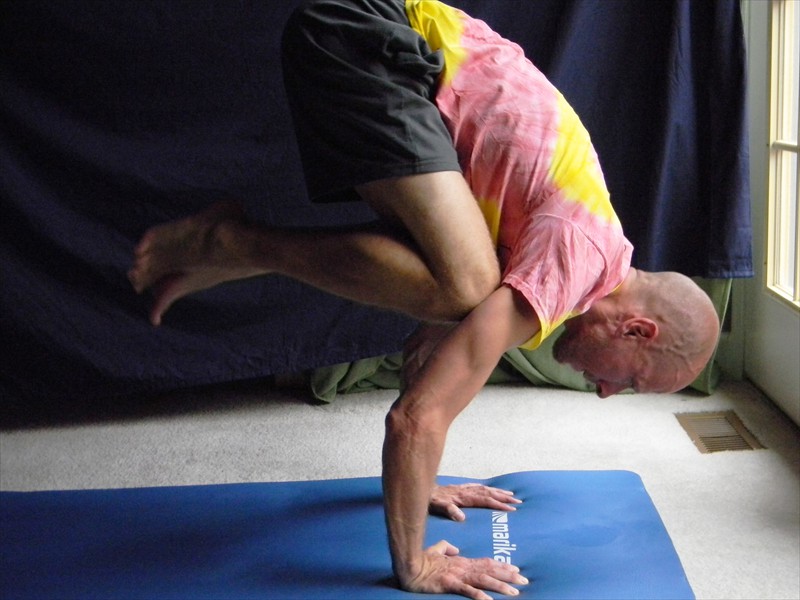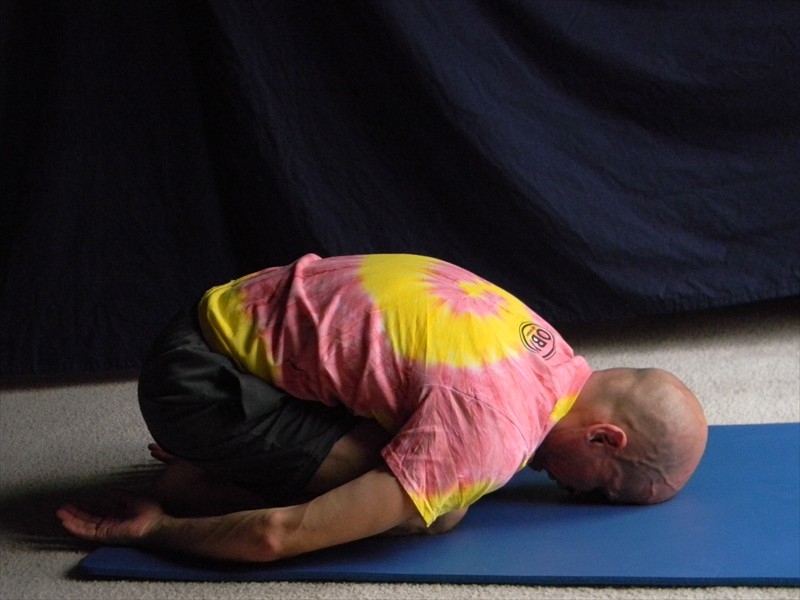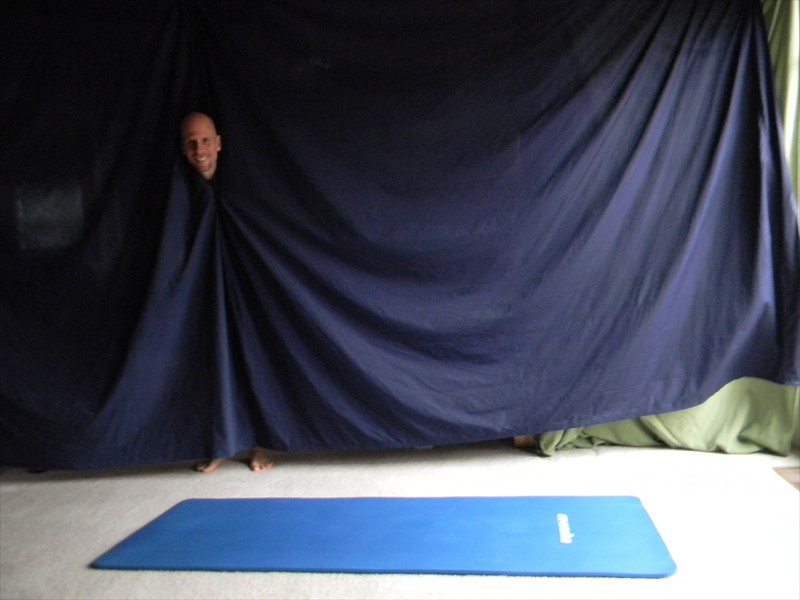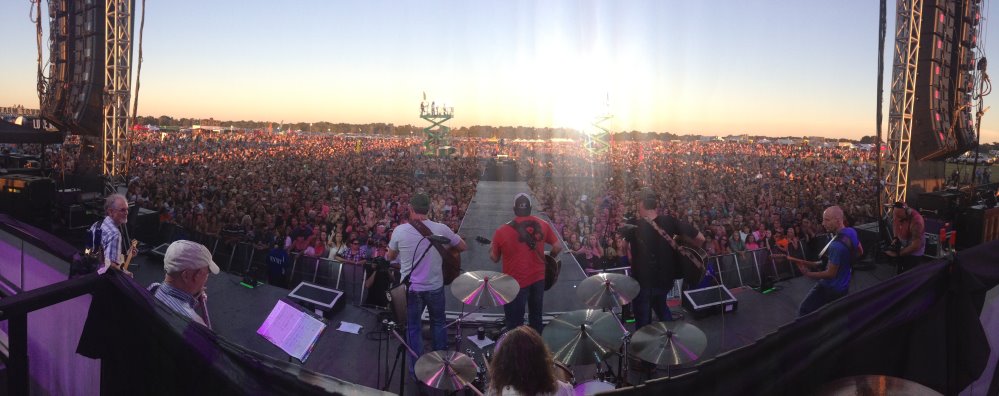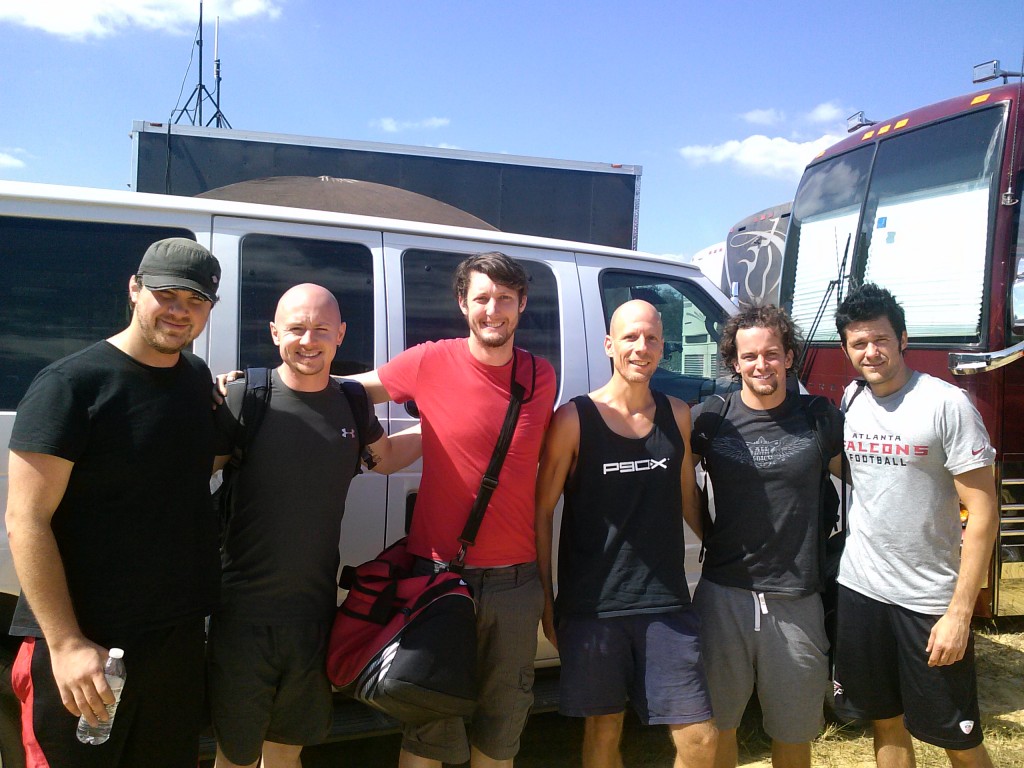
To say that last week was heavy is probably the biggest understatement of all time. Last week was one of the most emotional times I can remember in my adult life, I can’t even remember the last time I cried so much. When I first heard the news of the passing of my dear friend, Mike Chapman, I was deeply saddened, but I didn’t really grasp the full meaning of this for a couple more days. It wasn’t until me and Kelly arrived at Mike’s “Celebration of Life” ceremony on Friday that it fully hit me, Mike really is gone. 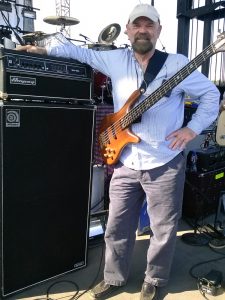
But he’s not really gone. His physical being may have left this world, but all the goodness he embodied and the huge impact that had on his family and friends remain. A part of his spirit is still here and lives within all that knew him.
I met Chap about 10 years ago, while working for country artist, Rhett Akins. We were in between bass players and our drummer at that time, Cliff Thompson said Mike would be great, if he was available. It turns out he was available, and our friendship and musical adventures began on a tour bus bound for Virginia. I had no idea on that day that he would eventually become my favorite bass player to play music with, but also one of my favorite people to be around.
Those that knew Mike knew the depths of his amazing talent on the bass guitar. Millions of people who have no idea who he is have unknowingly enjoyed his playing on countless recordings. Being a world-class studio musician and playing bass on all the Garth Brooks records (and countless others) were just one part of his amazing contributions to the world. He was also a phenomenal live musician; for he could hold down the fort like no other! My good friend, Patrick Weickenand, owner of a bar in which me and Mike performed many times, the Fillin’ Station, once said “Mike’s unreal, he never misses!”. Solid, dependable, never missing a beat – these words describe not just Mike’s bass playing, but his approach to life.
So many beautiful words were said of Mike at his celebration last week by some of his closest friends and his daughter Allison. Mike’s love for his family, friends, music, and life were as deep as the deepest ocean, his life had such meaning and purpose, and he lived it to the fullest. He was also the humblest guy you could ever meet, if he heard me (and everyone else) talking about him like this, he would have probably said something like “thanks, that’s really nice, but you don’t really have to say all that”.
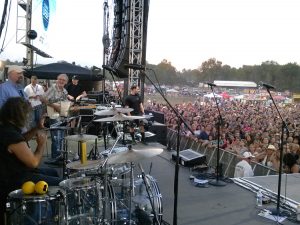 I played a lot of “big gigs” with Mike, most of the gigs with Rhett Akins and The Peach Pickers were in front of thousands of people. Some of my most memorable musical experiences were with Mike on bass backing up The Peach Pickers on the Luke Bryan Farm Tour in recent years. But hanging out with Mike on the bus, or sharing a meal or a walk, these moments were just as special.
I played a lot of “big gigs” with Mike, most of the gigs with Rhett Akins and The Peach Pickers were in front of thousands of people. Some of my most memorable musical experiences were with Mike on bass backing up The Peach Pickers on the Luke Bryan Farm Tour in recent years. But hanging out with Mike on the bus, or sharing a meal or a walk, these moments were just as special.
Over the years we also played a lot of small gigs, you know the kind, 30 or 40 people in a cozy neighborhood bar (or sometimes even five or six, three of which were 2 band wives and the bartender). My wife and I were always amazed that on many occasions he would drive an hour to do these gigs with me, for nothing other 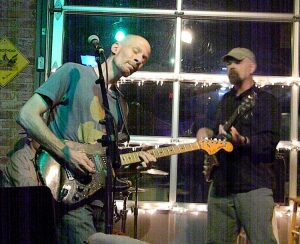 than tips and a good time. I remember him saying after one of these gigs “thanks for inviting me to the party! “, And after another “music is like ice cream!”. We really did have some magical musical moments in these little bars and I am grateful for the experiences and memories I made with him. He treated every show, no matter how big or small, with the same level of importance. He really loved to play music!
than tips and a good time. I remember him saying after one of these gigs “thanks for inviting me to the party! “, And after another “music is like ice cream!”. We really did have some magical musical moments in these little bars and I am grateful for the experiences and memories I made with him. He treated every show, no matter how big or small, with the same level of importance. He really loved to play music!
What Mike has left behind for us, aside from his musical legacy, is his legacy of love, and this was so evident at his service. One of the things I loved most about Mike was the way he would greet you with a big hug and a smile, every time! And it wasn’t just a little hug; he hugged you like he really meant it, as I believe he really did. And even if he didn’t physically hug you, he hugged you with his smile; there was so much love in his eyes. And this went on at the service, everybody was hugging everybody, it was like a great big, teary-eyed hug-athon!
In the days since that service my wife and I have talked a lot about Mike and some of the things that were said of him on that day – things like his honesty, integrity, compassion and selflessness. He never had a bad thing to say about anyone and went out of his way to help others, ideals the world can never have too much of. He generously shared his love with everyone and that might be the greatest gift anyone can give.
Over these last few days we’ve stumbled across a new mantra – “Be like Mike!”. If you’re having a bad day and life gets a little hard, hold your head up high and be like Mike. Be like Mike in all the ways that he shared his goodness in the world. Be like Mike and smile a little more, hug often, and love always. I can think of no better way to honor our friend.
Mike once said in an interview about attaining success in the music business “you’ve got to be a nice guy”. If there’s one thing I learned through my years of knowing him, being a nice guy came very naturally to Mike Chapman. I wish I could hug him one more time and play one more gig with him, but I guess that will have to wait. So if you’re listening my good friend, thanks for all the friendship, the music, and the love. And thanks for inviting us to the party!
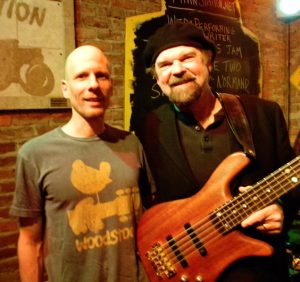
Back in 2009, I began putting together a list of people to interview for my book, The Nashville Musician’s Survival Guide, and my friend, Mike was at the top of this list. Those of you who knew Mike know that he was a very caring, giving, and humble human being. The interview he gave was not only insightful for aspiring musicians, but also a wonderful insight into his musical journey. Although he has now gone on to a better place, his music can still be heard, and his magical essence still shines through the words on these pages. It is with that spirit that I’d like to share his words with you all. Mike touched so many lives, and we are all the better for it. I miss my friend.
Use the buttons at the top or bottom of each page to move to the next page; the full interview is around 10 pages long.
This past Thanksgiving marks the second year anniversary of my yoga journey. It’s been an exciting year, lots of milestones and lots to be thankful for. At the one year mark, I decided to write a blog about my first year of yoga, so now that another year has come and gone I’d like to share how this transformational journey continues to evolve. For those of you who don’t know me, or didn’t read my first blog, I’ll start with a condensed version of how and why I got into yoga and then I’ll get into some of what I’ve learned during the second year (halfway through the writing of this blog I realized that it really wanted to be two blogs, one about the physical practice of yoga, and one about the mental and emotional benefits, so let’s start with the physical journey).
Throughout my adult life I’ve gone back and forth between two professions; music and construction. In 2011 I decided to go back into construction after many years of working as a touring musician. I was 43 years old and hadn’t worked in construction for about 15 years. Ouch, I was quickly reminded of how hard this work can be! Within a year I was having chronic shoulder and neck pain as well as relapses of tendinitis in my right arm from an old injury. Sometimes, after a few hours of work, my left shoulder would begin to hurt, the pain and stiffness spreading into my neck, ultimately limiting my range of mobility and causing intense pain. Once my shoulder and neck were “tweaked”, it might take several days to a week to subside. It was getting so bad that the condition could even be brought on by simply coughing or sneezing. I tried stretching, ibuprofen, lifting weights, but nothing worked, the condition was worsening.
Then one day a friend told me how he had used yoga to self heal an injury. I was intrigued. I began practicing with a yoga DVD (P90X Yoga) as well as putting together a few of my own short routines. I wasn’t consistent at first, but the ball was in motion. Then one day my wife, Kelly sent me a couple of YouTube video links. One was a 30 Minute Morning Yoga Class by Ali Kamenova (if you’re interested in exploring some great yoga videos, check out Ali’s YouTube channel). Almost instantly, this routine, and Ali’s style clicked with me, and soon this YouTube video had become my new best friend.
By one year into this commitment to self healing I was practicing Ali’s yoga routines almost daily, and the neck/shoulder pain and tendinitis were, for the most part, gone! Although they occasionally did show their face, the problems were minimal, and usually gone by the next day. There were a lot of other changes over that first year – a whole new sense of body awareness, breath, connectivity, improved attitude – I was stronger both physically and mentally, and had a growing sense of inner peace – all this from a 30 to 60 minute daily yoga practice at home. My first year of yoga was very exciting; self-healing my own injuries was very empowering. One of the biggest things I learned was the connection between the body, mind and breath, and I definitely felt an increased awareness of my physical and emotional state.
Figuring out what the body needs
When I first started practicing yoga, I was typically hitting the mat three times a week, occasionally 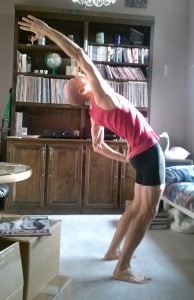 four. By the end of that first year it was almost daily, and I often found myself struggling to figure out what my body needed on a daily basis, which class to choose, what type of flow, how to alternate routines to target different parts of the body, etc. Maybe a certain area of my body was holding extra tension and required specific attention. I was also exploring how to build my day around my practice (to ensure it happened daily) and what clothing was most comfortable. Over the second year of practice, I gradually found answers to many of these questions.
four. By the end of that first year it was almost daily, and I often found myself struggling to figure out what my body needed on a daily basis, which class to choose, what type of flow, how to alternate routines to target different parts of the body, etc. Maybe a certain area of my body was holding extra tension and required specific attention. I was also exploring how to build my day around my practice (to ensure it happened daily) and what clothing was most comfortable. Over the second year of practice, I gradually found answers to many of these questions.
Creating a space for yoga
In order to practice yoga every day I believe you have to build it into your daily routine in a way that is sustainable, and this is different for everyone. I’ve learned that I don’t have the energy or focus for a challenging yoga sequence by the time I get home from work, so it’s pretty much a morning practice or nothing. For a while, I tried hitting the mat shortly after getting out of bed, and this was a struggle as my body was too stiff and I seemed to lack energy. Gradually, my schedule evolved into waking up around 5:00 AM, eating breakfast, doing a few other things around the house to kind of wake things up a bit, and then starting my practice at the last minute possible before leaving for work (allowing maximum time for digestion). On the weekends I find myself practicing much later in the morning and my body seems to like that a little better, but the compromise during the work week is essential. I think the key is to make a commitment to a daily practice, and then build the practice into your daily routine.
Types of routines:
I love a strong, moderate paced power yoga class, 50 to 60 minutes in length, with lots of warriors, backbends, twists, hip openers, and core work, and I do these as often as possible. However, sometimes my body wants something different. On some mornings I feel a little beat up from the workday before, so I might do a less intense routine that focuses on flexibility. I use these classes to take the edge off of whatever pains and tweaks I might wake up with and to prepare my body for another day of life’s abuses. Do you ever wake up feeling really tight, achy, and just really beat up from head to toe? Well even with all this yoga I still have days like that, too. On those mornings I try to do very easy, therapeutic routines, maybe 20 to 30 minutes in length with mostly seated poses. And then some days the body just wants a complete rest! Our physical state seems to fluctuate, going from higher to lower points of energy and stability, so it’s important to listen to your body; it is speaking to you and will tell you what it needs.
Staying Loose
Loosening up, tightening up, loosening up, tightening up…this seems to be a pattern in my life. I get all stretched out with a wonderful morning yoga class, and then sit in my car for an hour drive to work. Sitting in traffic sucks, and boy, will that tighten you up! Then there’s the repetitive motion of the job itself. Throughout the day, I’ll throw in a few poses, almost always right before lunch, and then again at the end of the day right before the afternoon commute. Even just a couple of forward folds and a standing side stretch can work wonders.
Making the body more efficient and workplace yoga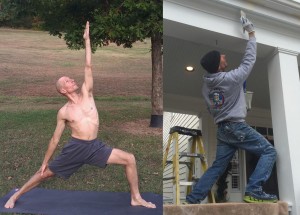
My job as a painter and drywall repairman is very physically demanding and requires a lot of sustained, awkward body positions. Working over head, crouching, kneeling, climbing up and down ladders, painting with a brush or roller for hours…did I mention sitting in traffic? No matter what you do for work; it will take its toll on the body. This is where yoga comes in. For every task that stresses the body, there’s a pose or group of poses that will counter it.
Painting and/or repairing ceilings place more stress on the neck and shoulders than almost anything else I do. Over the last two years I have greatly increased my flexibility in that region with backbends, twists, and shoulder openers. This work still takes its toll, but much less so because of my increased range of motion. Work that is low to the ground, like painting baseboards, is also quite taxing. You’ve 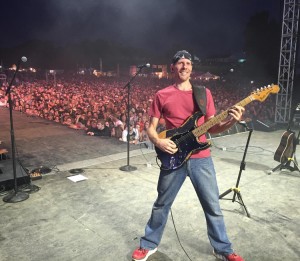 either got to sit, kneel, crouch, or lie on your side. I find myself sitting crosslegged to do a lot of this work, kneeling (with knee pads), or even squatting, and this requires open hips and loose hamstrings. Hip openers and hamstring stretches improve the ability to sit or kneel for extended periods of time. I’m constantly going from standing, to crouching, to climbing ladders, and this is where all the core work really pays off. Working over head or standing on a ladder requires the ability to balance and an awareness of my body in space. Balancing poses greatly help (if you want to get a sense of where you’re really at, try closing your eyes during tree pose!). When I perform music, I might be playing guitar and singing continuously for an hour or more, and this can be just as demanding as painting a house. All the muscles that get used and abused by performing music are stretched and strengthened by my yoga routines.
either got to sit, kneel, crouch, or lie on your side. I find myself sitting crosslegged to do a lot of this work, kneeling (with knee pads), or even squatting, and this requires open hips and loose hamstrings. Hip openers and hamstring stretches improve the ability to sit or kneel for extended periods of time. I’m constantly going from standing, to crouching, to climbing ladders, and this is where all the core work really pays off. Working over head or standing on a ladder requires the ability to balance and an awareness of my body in space. Balancing poses greatly help (if you want to get a sense of where you’re really at, try closing your eyes during tree pose!). When I perform music, I might be playing guitar and singing continuously for an hour or more, and this can be just as demanding as painting a house. All the muscles that get used and abused by performing music are stretched and strengthened by my yoga routines.
Breathing is the only way to deepen our practice
Anyone who has delved into yoga, even just a little bit, knows the emphasis placed on breathing. When we breathe deeply, with complete inhalations and exhalations, our body receives this as a signal to relax and to let go of tension. Sometimes I become aware of growing tension, and a few focused deep breaths almost always help to relieve it. If I do something that aggravates or tweaks a muscle, breathing can help to minimize, or even reverse what might otherwise become a runaway problem. As a chronic sufferer of migraines, I’ve learned that deep breathing can be a very powerful tool. And deep breathing can be especially helpful in dealing with the simple stresses of everyday life, arguments, traffic jams, etc.
I’ve learned so much in these last two years about how my body works, what it needs, how to use yoga to become less prone to injury, self heal injuries, and to optimize my physical and emotional well-being. My yoga practice, along with healthy eating is my own personal healthcare system. I believe it can have a powerful effect on anyone, and the best part is, it’s never too late to start. The transformational effects of my practice go way beyond increased strength and flexibility, and part two of this blog will delve into the positive effect it can have on mental and emotional wellness. As my initial exploration of yoga was centered on fitness, as it seems for many, I wanted this blog to partly serve as an inspiration or catalyst to those who are curious about it, or just getting started with their own practice.
Yoga practice seems to be dominated by women, and I think a lot of men don’t get into it because they don’t really understand what it can be. A big misconception among many who have never practiced yoga is that it’s all about meditation, or just for “stretching”. While it does include those things, the right kind of yoga routine can be as ass-kicking as any workout you’ll ever do. At its core, yoga is really about self exploration, and the breath, but it can also be an amazing physical fitness program. And with that, I’ve got to get going. It’s almost time for work and I’ve got to go hit the mat!
Here’s some photos my wife took during one of my recent yoga sessions (click or swipe the arrows to see all the photos): the before and after shots show my progress from one year ago.
During the last Nashville Berklee Jam to be held at The Rutledge, which sadly closed its doors shortly thereafter, international rock star, author, and motivational speaker, Zoro addressed a room full of hungry musicians with a heartfelt, life-changing talk. Well known as a professional drummer who’s played with the likes of Lenny Kravitz, Bobby Brown, and Frankie Valli, among countless others, Zoro, often referred to as “The Minister of Groove”, is also an educator who has given hundreds of clinics and authored the critically acclaimed “The Commandments of R&B Drumming”. He’s also known in the world of motivational speakers, having given hundreds of talks and authoring the book “The Big Gig – Big Picture Thinking for Success”.
But tonight’s talk was not about drumming, and while it delved into the world of professional musicians and artistry, at the core of this talk was a universal message that applies to all humans, that of finding your purpose in the world by discovering and maximizing your strengths. After his talk I was honored to participate in a performance with Zoro and A-list Session bassist, Mike Chapman. There’s a video of Zoro’s talk and some of this performance at the end of the article. Here are a few excerpts from his talk: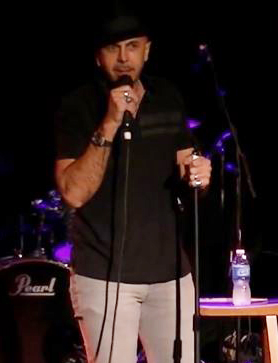
“The world has changed more in the previous 50 years that it has in the last 5000…. but there’s a few foundational things that I think will never change…Each person in this room is born is born with a certain gift and a certain talent. And for many of us, it’s musical talent. What will not change is excellence…no matter where the world goes or where music is headed, to me, if you have a musical gift, the most important thing is to exercise it, to develop it and to make it, point blank, excellent… I always feel that if you do something really, really well, eventually there’ll be a place for it somewhere. In a world where people don’t do things on a high level anymore, I still think that being excellent will make you stand out amongst the crowd…”
He spoke of diversity and the need to hone in on your strengths:
“I think each person here has more than one ability. I think your musical ability is one of them, but I think there are many. For me, I just pursued things that were naturally instinctive to me and interested me naturally. I wasn’t thinking business, I wasn’t thinking in 30 years I can be drumming, and be an educator, an author and speaker… I was thinking ‘I like writing… I’d like to write an article to help people. I like teaching’… so everything became a natural evolution of things I was already good at… so don’t worry about what you’re not good at, there’s going to be plenty, find out where your strengths are and then work on turning those into something that’s really monumental and excellent.”
I loved his take on marketing:
“The best marketing tool in the whole wide world is to just be bad-ass at what you do…because other people will tell people about you… people take notice of excellence, whatever it is. How many of you, when you go to a restaurant, take notice of someone who is an excellent server? We all notice when people do a good job…when I see a movie that’s great I tell everybody about it, but when I see one that sucks I also tell everybody don’t go waste your money.”
Often overlooked in the music industry as well as many others is the shortage of, and need for extreme professionalism:
“Some of the things it takes to succeed are very practical, but I find they seem to slip by the musical community. Things like; being on time, coming prepared, having your stuff together, being reliable… half of success is just showing up on time and just being ready. These things to me are totally obvious, but they seem to slip by a lot of the people that are creative.”
Perhaps one of the most important points he makes is that We Are in the Service Industry!
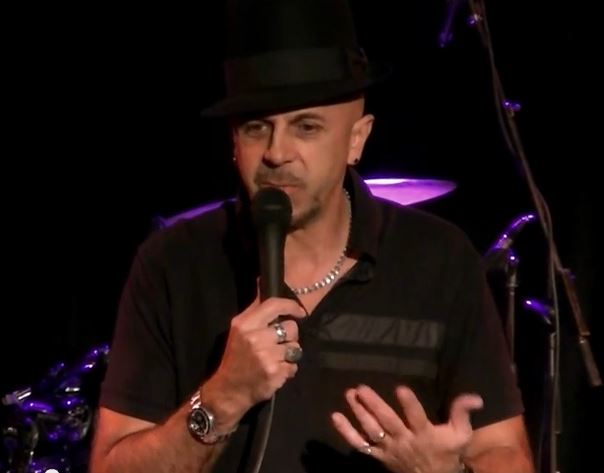 “Be accommodating. I look at everything that I do as really one thing, I’m a servant. I’m here to serve. Tonight I’m here to serve with my words, and I’m here to serve with my playing. I’m never here to be served, always here to serve… a lot of people have a perception of rock ‘n roll and fame… everyone’s catering to you and everyone’s worshiping you… there is an element of that that’s true, but I don’t perceive it that way. I perceive it as I have an opportunity and a platform, and an opportunity of privilege to serve people… I’m either serving the artist I’m playing with, or the crowd that I’m playing to.”
“Be accommodating. I look at everything that I do as really one thing, I’m a servant. I’m here to serve. Tonight I’m here to serve with my words, and I’m here to serve with my playing. I’m never here to be served, always here to serve… a lot of people have a perception of rock ‘n roll and fame… everyone’s catering to you and everyone’s worshiping you… there is an element of that that’s true, but I don’t perceive it that way. I perceive it as I have an opportunity and a platform, and an opportunity of privilege to serve people… I’m either serving the artist I’m playing with, or the crowd that I’m playing to.”
On creativity and vision:
“One of the greatest gifts human beings have… is the ability to dream… To dream up something that never existed and then to have the privilege of creating it is the greatest privilege in the world. And we all have that ability to dream and to believe that if we are willing to act on it and pursue it, we [can] turn that dream into a reality. It’s a great privilege and that’s what makes life really fascinating and interesting.”
He began a few words about the journey of self-discovery and life with a quote from Mark Twain:
“Most of us are anxious to be praised for the one gift that we don’t possess, rather than the 15 that we do.”
“If you don’t learn to enjoy the journey, the process, you’ll never enjoy life…the joy of life is in the process itself, and the journey of learning and growing and developing, that’s what life is…When people are not fulfilled it’s because they’re not moving toward something. You’re created to have purpose, to be moving forward in a direction towards the accomplishment of something.”
We’ve had many great guests speak at these events, all of them with unique angles, many catering to specific niches, and they’ve all been inspiring. This talk really got me thinking on many different levels and was one of my favorites to date. No matter what you do in life or what you do for a profession, many of life’s challenges and problems are universal. We can all work to discover our gifts, to hone them, to share them, to allow them to let us shine a little light in the world. Don’t let your dreams sit on the sidelines, find your gifts and make them excellent!
I would like to thank Zoro for sharing his words of wisdom and inspiration and for kicking out a great jam! I would like to thank Jeffrey Lien for helping me host this event and hooking us up with Zoro, the Rutledge and Andy Aquino for hosting our events for the past two years, Frank Sass for always providing great sound and lighting, and Jack Zander for capturing all the magic on video.
Zoro’s Talk (39 minutes)
https://www.youtube.com/watch?v=p0JPstlJAFQ&feature=youtu.be
Hear My Train A Comin’
https://www.youtube.com/watch?v=45iiMtKErwg&feature=youtu.be
Cissy Strut (with 5 minute drum solo)
https://www.youtube.com/watch?v=bXtXOzt5jNA&feature=youtu.be
Namaste, friends and fellow Yogi’s! If you’re not a regular yoga practitioner, you’re probably not familiar with this greeting, don’t worry, until recently, I wasn’t either. Almost exactly one year ago from the time of this writing I embarked on my journey into yoga, one which was prompted by an almost debilitating battle with chronic shoulder and neck pain. A year later, after making a serious commitment to try yoga as a holistic approach to self healing, the injury is healed and I am relatively pain free. Before I delve into the healing and transformation that happened over this life-changing year I’d like to tell you how I arrived at this place.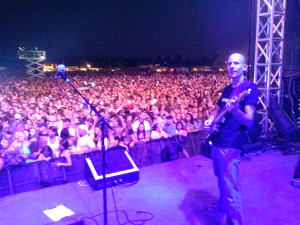
For most of my life I’ve been a musician, having earned a living as one for most of my adult life. I’ve been playing professionally on and off since 1989, having played thousands of night club gigs before moving from my native New England to Nashville, TN in 2002. Since my arrival to Nashville, I’ve played another thousand or so gigs, most of them as a professional touring musician. I even wrote a book about the Nashville music industry in 2011. About three years ago, the artist I was touring with decided to stop touring, and I used this moment to make a change. Having seen the country from a bus window several times over, I also decided to stop touring. I had no idea what I was going to do next.
A fellow musician whom I had played a few local gigs with owned a painting company, and one night on the way home from a local show said “If you ever feel like swinging a paint brush, let me know, I’m always looking for good help”. I took him up on his offer, as painting and drywall is something I’ve also done at different points of my life. At first I just worked a couple days a week, but a year later, now 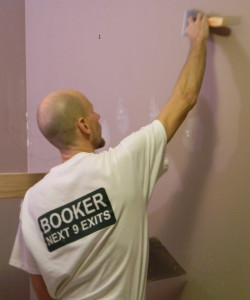 up to four to five days a week and still playing music part-time, this pace began to kick my ass! Not having done physical labor in over 10 years, I soon began having regular pain in my left shoulder and neck, as well as some relapses of tendinitis in my right arm from an old injury. The shoulder pain sometimes caused my neck to stiffen up, often to the point where I lost mobility and could barely turn my head to the side. It was getting ugly!
up to four to five days a week and still playing music part-time, this pace began to kick my ass! Not having done physical labor in over 10 years, I soon began having regular pain in my left shoulder and neck, as well as some relapses of tendinitis in my right arm from an old injury. The shoulder pain sometimes caused my neck to stiffen up, often to the point where I lost mobility and could barely turn my head to the side. It was getting ugly!
Like many Americans, I didn’t have health insurance, I haven’t for most of my adult life. So I knew I had to go about this holistically. I was already eating pretty well, as I had been for several years. I’m not vegan but I do eat lots of fruits and vegetables, whole grains, legumes, healthy oils, nuts, and lots of water, with meat and dairy only being a small part of my diet. I avoid processed foods and almost never eat in restaurants. As far as exercise, at the time these problems began, I had been doing the P90X workout program on an off for about two years, and sometimes went on hikes. I was relatively fit, but my exercise habits were inconsistent. I started doing the P90X stretch DVD on a regular basis, and while this seemed to help, it wasn’t enough. I started doing the resistance exercises again, and sometimes they seemed to help, other times they seemed to aggravate the injuries.
By the end of this second year of construction I was at my wits end, the nagging shoulder problem now an almost daily occurrence and the tendinitis not far behind. I was determined to remedy the situation holistically; I knew it could be done as my wife had just conquered a bad neck injury from a car accident through regular exercise. I needed a new approach, as it seemed like everything was just too tight and getting tighter – shoulders, neck, and a whole bunch of muscles I didn’t even know the names of. I had some earlier experiences with yoga, mostly from the P90X yoga DVD, and, remembering how good I felt after those workouts, I began exploring it again. Around the same point in time a friend of mine told me how he had used yoga to heal a chronic injury. For the next few months I began doing yoga, mainly using that DVD or just putting a few poses together on my own. I wasn’t doing it with any real consistency or plan, but I was doing it.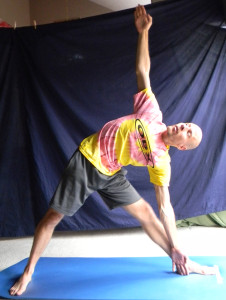
Then one day a bulb went off in my head. I remembered something that a Soft Tissue Specialist once told me about my tendinitis. He said something to the effect of:
“The tendinitis in your forearm is the result of inflamed tendons and muscles rubbing. There’s an overlapping series of tendons and muscles that go all the way from your wrist to the back of your shoulder. So the problems in your forearm are also related to tightness in your triceps, and shoulder. You can’t just work on the one area of inflammation, you need to stretch everything around it, lengthen everything.”
Realizing that my shoulder and neck problem likely worked in the same way, I figured that yoga might be the perfect choice for something to stretch and strengthen my whole body. Right around this time my wife sent me a couple of links to some yoga classes on YouTube, one of them was a 30 Minute Morning Yoga Class by Ali Kamenova. I’m not sure if it was the unique and challenging flow to this class, or maybe her soft, steady and almost hypnotic voice delivering detailed explanations of form with a cool, Bulgarian accent, but something just clicked for me when I did this class. This was the beginning of my serious commitment to yoga.
For the first couple of months into my new commitment I did this same 30 minute routine 3 to 4 times a week, basically every other morning. I noticed the shoulder pain was diminishing and I was becoming less “tweak prone”. I started experimenting with some of Ali’s other classes and honed in on a 66 minute Vinyasa sequence that covered all the basic poses, adding this to my weekly rotation. I also began doing regular cardio, the “run-walk–run” method, basically, interval running about 2 to 3 times a week. By the time six months had passed from my initial commitment I realized I hadn’t had any major flareups in a while. I found another challenging Ali video that resonated with me, “Arm Balances Emotional Release”, and added this to my weekly regimen of yoga and running. Ali’s style of yoga, “interval yoga”, is not your traditional yoga. Many of the videos add elements of strength training and cardio, making the classes challenging on many levels.
It’s not about the hour a day that I do yoga, it’s about the other 23 hours.
During the second half of this transformational year, I began to notice a lot of other changes happening. Not only was I in less pain, I felt stronger and noticed having more energy throughout my days. I noticed feeling less beat up when I awoke in the morning. A lot of other subtle changes were happening – better posture, body awareness, deeper breathing, I even noticed that my attitude was becoming more positive. I began to make the connection between negative thoughts and tension and pain. It was obvious that my exercise routines were improving many aspects of my life.
The intermittent shoulder and neck pain that started me on this journey was often triggered by many different things. Sometimes it was from looking up for extended periods of time at work, turning my head to the side in an unsupportive way; even sneezing could trigger a spasm. These spasms would escalate to the point of constant pain and tension in the shoulder, eventually working its way into my neck and causing a limited range of motion. Once a spasm began, it would take anywhere between three days and a week to get under control. It’s not like I’m invincible now, but I haven’t had a major spasm in over six months, and if I do have a tweak, it’s much smaller now and typically gone the next morning. I am certain that it was this serious commitment I made to myself that allowed me to self-heal these injuries, as my physical problems were worsening before this intervention and I never once went to a doctor for any of this.
The benefits of Yoga in everyday life
Life can be challenging, work can be hard, and nothing is ever easy. No matter what you do I’m sure there are moments throughout some of your days when you are in physical or emotional pain. Here are some of the concepts and practices I’ve learned from yoga that seem to help ease some everyday struggles.
Breathing – It seems ridiculous that fully grown humans would need to examine their breathing. But 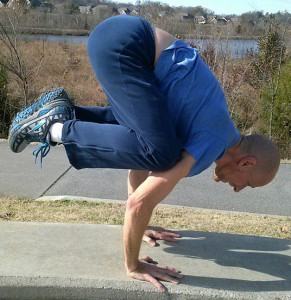 the truth is that many of us use shallow breathing much of the time. If you haven’t been doing yoga or another exercise in which breathing is integral, then you’ve probably never given it much thought. “Deep inhalations followed by deep exhalations”. Throughout my days, as often as possible, I check in with my breath. Am I breathing deeply or have I gotten lazy. Breathing deeply seems to help the body stay loose and the mind, calm and centered. Whenever I have to climb way up high on a ladder, I’ll take a few deep breaths first. I’ll do the same thing if someone cuts me off in traffic, if I feel an argument about to ensue, or if I’m getting nervous before a performance.
the truth is that many of us use shallow breathing much of the time. If you haven’t been doing yoga or another exercise in which breathing is integral, then you’ve probably never given it much thought. “Deep inhalations followed by deep exhalations”. Throughout my days, as often as possible, I check in with my breath. Am I breathing deeply or have I gotten lazy. Breathing deeply seems to help the body stay loose and the mind, calm and centered. Whenever I have to climb way up high on a ladder, I’ll take a few deep breaths first. I’ll do the same thing if someone cuts me off in traffic, if I feel an argument about to ensue, or if I’m getting nervous before a performance.
Posture – one of the best things about yoga is the emphasis on body alignment, and this transcends into posture. “Shoulders back and down, tuck your butt, lift through the crown of your head, relax your shoulders, don’t hyper extend your knees” – hearing these phrases repeated over and over in the workouts has helped me cultivate better posture even when I’m not working out. I can’t think of how many times throughout the day that I catch myself faltering when suddenly one of these phrases just pops into my head. I’ve also re-examined how I sit, often now choosing to sit crosslegged in a chair, or even on the floor. I believe good posture is half the battle.
Body Awareness – the more I do yoga, the more I become aware of how my body feels at any given moment in time and space. Now that I’ve got my two biggest ailments under control (the shoulder and tendinitis), I’ve become aware of other minor discomforts that have been there all along, possibly going back years. These are not a big problem; they are simply areas of tension or limited mobility to work on long-term. Also, if I’m pushing myself too hard throughout any given day or just getting tired, I become aware of growing tension and work to relieve it.
Stretching – a few times throughout my day, I’ll throw in a random stretching pose. I love to just hang in a forward fold for a minute or so right before lunch or driving home at the end of the day. Sometimes I’ll just do it if I feel myself getting tight. I’ll also do downward dogs, back bends, and other poses to counter building tension or tightness, when necessary.
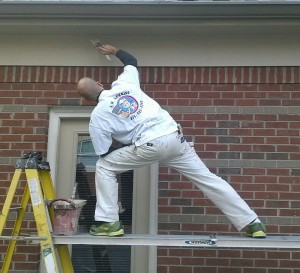 Body mechanics – to me this is the art of efficient and safe movement, and I’m aware of this now more than ever. What is the easiest way to do any given task? Whether it’s playing guitar, painting, sitting at a computer, I’m always searching for the safest and easiest way to do it.
Body mechanics – to me this is the art of efficient and safe movement, and I’m aware of this now more than ever. What is the easiest way to do any given task? Whether it’s playing guitar, painting, sitting at a computer, I’m always searching for the safest and easiest way to do it.
Attitude – Out with the negative in with the positive! Stress and tension can definitely cause physical pain, so it only stands to reason that having a positive outlook can make one healthier. One aspect of yoga is quieting and clearing the mind. Getting good at this seems to have a direct correlation to preventing injuries and living with less pain, not to mention, increased happiness. I find that the meditative aspect of yoga brings great inner peace and calmness.
Paying It Forward – Yoga has been such a powerful force in my life that I want to share with others, and I’ve already taught a few moves to a few friends. I have a long-term goal of becoming a yoga instructor, not to make a living from it (I’ve heard that’s pretty hard to do) but because I want to learn it on the deepest level possible and share that knowledge with others. Yoga seems to be female dominated, with many men shying away from it for a variety of preconceived notions. Seeing many of my friends living in pain has given me the desire to help change that and make yoga more accessible to men.
I can’t say enough good things about what yoga has done for me. I’ve learned entirely through home practice, almost exclusively using Ali’s videos. Ali has been a great teacher, responding to messages with advice and encouragement. She seems to do this for a huge amount of people all around the world. It’s an amazingly altruistic venture she has embarked on to make yoga so accessible to so many (she has over 200 free full-length yoga classes and tutorials on YouTube!), and to give such personal attention to everyone who seems to need help.
At age 46, I feel like I’m in the best shape of my life. No matter what fills my days – painting a house, 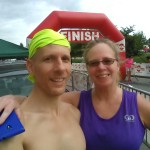 performing music, spending time with my family, running at the park, or yoga – I don’t think I’ve ever been in a happier, healthier place. We all live in varying degrees of pain, be it physical or emotional, and I believe yoga is the best pain management program of all time. There’s a reason it was invented and used over 5000 years ago as the original healthcare system in India. I’m grateful to be a part of this tradition and thankful that it found me. There’s still so much to be learned, so I better get started. Namaste!
performing music, spending time with my family, running at the park, or yoga – I don’t think I’ve ever been in a happier, healthier place. We all live in varying degrees of pain, be it physical or emotional, and I believe yoga is the best pain management program of all time. There’s a reason it was invented and used over 5000 years ago as the original healthcare system in India. I’m grateful to be a part of this tradition and thankful that it found me. There’s still so much to be learned, so I better get started. Namaste!
“The gesture Namaste represents the belief that there is a Divine spark within each of us that is located in the heart chakra. The gesture is an acknowledgment of the soul in one by the soul in another.
Nama means bow, as means I, and te means you. Therefore, namaste literally means “bow me you” or “I bow to you.”
Here’s some photos my wife took during one of my recent yoga sessions (click or swipe the arrows to see all the photos):
By Eric Normand
At the August Nashville Berklee Jam we were fortunate to have an expert in the field of music for television and film – songwriter and CEO of Song Placement International, Kate Taylor. A native of Michigan, Kate has been in Nashville since 1999 and has had her songs placed in shows like “The Young and Restless”, “Teen Nick”, CMT, and countless others. Through her song placement company she has placed songs for hundreds of artists and is currently working with shows like “Grey’s Anatomy”, “Nashville”, and “Duck Dynasty”, to name a few. Here are a few highlights from her in-depth talk about the ins and outs of getting music placed in TV, film, video games and commercials. (A video of Kate’s entire talk can be viewed at the end of this article.) 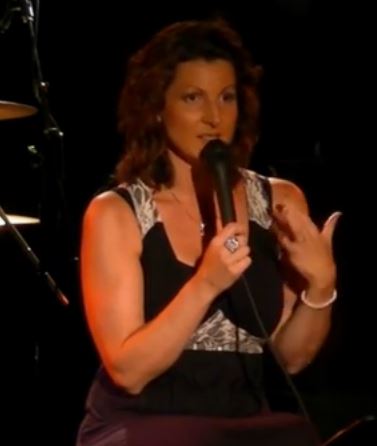
“Adam Zelkind, a dear friend of mine and a mentor to me once said ‘Kate, if you can make a penny in music, take it. If you can make a penny it will become a dime. Eventually all those dimes will add up to a million dollars.’ I don’t know if you know who Adam is, but he’s a millionaire just from making TV music.”
Adam was Kate’s mentor early on in her career of making music for TV and film and was pivotal in her advancement in this field. Eventually, Kate would team up with another Adam, Adam Stengal along with another music industry veteran, Howard Rosen to form her placement company “Song Placement International”. Together, this trio has created a formidable force in this elusive field.
Regarding some basics about song placement Kate had a few words of wisdom to offer:
- If you get in contact with a music supervisor directly, that email is gold, don’t ever lose it.
- When you e-mail them, ask them “how do you want the music?” (Most want a link).
- Unless they are willing to pay over 25K for the initial sync fee it is not worth doing an exclusive deal. Most syncs are non-exclusive.
- Steer clear of “re-titling”. Re-titling is when a song placement company changes the title of a song so they can own the publishing and masters.
- If you’re song is vocal-based, always send the instrumental track as well.
- Re-makes of known cover songs work great for T.V., just make sure you have the permission to do the re-make.
Advertising provides the most lucrative opportunities for song placement, for example, a car commercial might pay $25,000 upfront. Next in line would be TV, with major network nighttime show placements starting in the $4-$5000 range for indie artists.
Regarding genres – “They want everything…hip-hop, singer-songwriter, orchestral, driving beat…the more variety you have, the better chance you have of getting placements.”
She also added that lyrical content doesn’t matter so much when it comes to TV music…“it’s all about the dialogue over the top of the music”.
Kate expanded on many of these points at length and by the end of her talk it became clear that music placements in TV, film and video games are a largely unexplored area for many songwriters and artists. As most songwriters are striving for cuts with major artists or trying to achieve their own success as artists, many don’t realize that this angle can be a means to an end while they’re working towards other goals. And, perhaps even more importantly, making music for tv and film can be a more easily obtainable goal.
If you think your music is worthy of being placed in tv or film, Kate would be more than happy to hear from you. You can contact her at kate@songplacementinternational.com – please send links only, no song attachments.
https://www.youtube.com/watch?v=2eWaE_gZkyE&list=PL8RXighnAxWIT_c0-P-LO28gV7GkP9rVh
Kate Taylor performing her original song “homecoming Queen”
https://www.youtube.com/watch?v=ODa0hzb5IOg&list=PL8RXighnAxWJ4DZcKjF3KPXa-HZMYekkK
By Eric Normand
Sunny days, dusty hayfields, huge crowds, great music, great people, light beer, diesel fumes, gator balls – these were the sights, sounds and aromas of the 2014 Luke Bryan Farm Tour. I can’t believe it’s over, it seems like I just hopped on the bus yesterday. The 8 shows spanning two weeks whirled across the Deep South with the speed of a jet plane and the intensity of a freight train.
My role in this mega-tour as lead guitarist and bandleader for Nashville’s most successful songwriting team of all time, The Peach Pickers, began with our pre-tour warm-up show at a sold out Third and Linsley in downtown Nashville on September 26. The show, which benefited The Wounded Warrior Project was a huge success, and a couple of days after this electric night we hopped aboard a bus bound for Knoxville, TN.
Even though it was October 1, it still felt like summer when I hopped off the bus around 8 AM, the temperature already approaching 80°. This day began for me like every day that would follow on this tour, a trip to catering! After some eggs, home fries and coffee I got ready for my daily trip to the gym with members of Luke’s band and one of the other opening bands, Cole Swindell. While I was doing my thing at the gym, other members of our entourage walked the hayfields, while others took advantage of another luxury provided to the touring musician, sleeping late.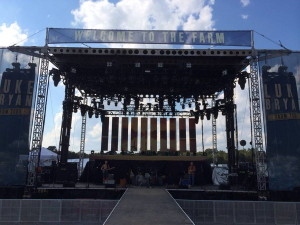
By mid-afternoon it was time for our load-in and sound check. The level of production on this tour was top notch, sporting state-of-the-art lighting, some really cool video walls, and a PA system that would rival that of any mega-rock tour. They even had a remote-controlled flying camera that captured video footage of the audience and performances, otherwise referred to as “the drone”.
Luke’s crew, along with the other crews (which included the world-class sound company, Claire Brothers) not only knew how to make us sound and look great, they were a pleasure to work with. After sound check it was time for a little rest, a quick shower and some dinner before taking the stage at 6:40 PM. Our 40 minute set began just a few minutes after the tour’s first opener, Louisiana native and singer-songwriter, Chancie Neal. The sun was just beginning to set as the DJ introduced our show with something like:
“These three guys are the most successful songwriting team in the history of Nashville. They have 60 number one hits…230 million downloads… please welcome to the stage – Rhett Akins, Ben Hayslip, Dallas Davidson…The Peach Pickers!”
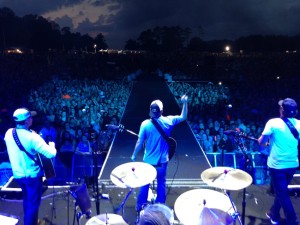 The crowd went wild and we began our onslaught of 13 number one songs with “The Only Way I Know”, a Peach Pickers cut by Jason Aldean. In rapid-fire succession we played down our list, each song greeted with, and followed by the sound of 15,000 people going absolutely berserk! After a few rockers we slowed things down with the heartfelt ballad “I Don’t Dance”. A few of the songs towards the end of our set really seemed to hit home with themes that everybody in this crowd could relate to – “Small Town Throwdown”, “Parking Lot Party”, “All about Tonight”, and the epic hip-shaker, “Boys Round Here”. The set went by like a blur, seeming to end as quickly as it began, and the three stars of our show left the stage to a deafening applause. The crew and stagehands helped us tear down and pack up our gear with lightning speed, and by quarter of eight it was all loaded on the bus and we were done working for the night. Only six more hours until bedtime!
The crowd went wild and we began our onslaught of 13 number one songs with “The Only Way I Know”, a Peach Pickers cut by Jason Aldean. In rapid-fire succession we played down our list, each song greeted with, and followed by the sound of 15,000 people going absolutely berserk! After a few rockers we slowed things down with the heartfelt ballad “I Don’t Dance”. A few of the songs towards the end of our set really seemed to hit home with themes that everybody in this crowd could relate to – “Small Town Throwdown”, “Parking Lot Party”, “All about Tonight”, and the epic hip-shaker, “Boys Round Here”. The set went by like a blur, seeming to end as quickly as it began, and the three stars of our show left the stage to a deafening applause. The crew and stagehands helped us tear down and pack up our gear with lightning speed, and by quarter of eight it was all loaded on the bus and we were done working for the night. Only six more hours until bedtime!
Our show was followed by the fast rising, Cole Swindell, another Georgia native currently enjoying his second number one song, and his four-piece band kept the party going full force. By 9 PM it was time for the Tour-D-Force of this event, Luke and gang to take the stage, his show beginning with the modern day phenomenon of thousands of cell phones being raised into the air to capture an endless barrage of digital photos.
Luke’s show is an exciting ball of kinetic energy, his top notch band providing an AC/DC like “foot stompability” that kept the audience pulsating for his 90 minute set. The phrase “sing along” doesn’t even begin to paint the sonic picture of the sound of 15,000 people singing at the top of their lungs at a Luke Bryan concert. After Luke’s show ended, the crowd quickly dispersed the field, only to be trapped in a massive traffic jam as thousands of cars began their slow motion journeys down the one lane road that led out of this little piece of rural America.
This first day and night of the tour was a huge success, and with each following show, the tour seemed to gain momentum. The only snag of this first week was some torrential rain during Friday afternoon in Tallahassee Florida, and despite what seemed like an impending disaster, the rain subsided right before showtime and the night went off without a hitch. The following night we ended the first leg of 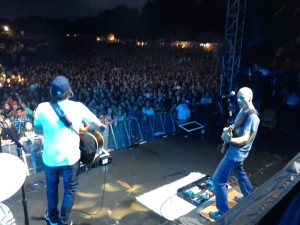 this tour to a crowd of 17,000 in Gainesville Florida, and this was, in my opinion, The Peach Pickers strongest performance yet.
this tour to a crowd of 17,000 in Gainesville Florida, and this was, in my opinion, The Peach Pickers strongest performance yet.
A few days off and we were back at it for round two. The week started out smoothly, but late Thursday afternoon in Columbia, South Carolina it began to sprinkle, with the sounds of thunder and the view of lightning in the distance. Oh no, it was happening again! We pushed back the start of the performances by 20 minutes, and midway through Chancie’s set a downpour began. With a handheld wireless microphone, this brave girl stood out in the pouring rain on the middle of the runway and kept everybody’s spirits high. By the end of her show she was soaked head to toe, as was her acoustic guitar player and percussionist, Austin Marshall (who also just happens to be the Peach Pickers tour manager). The rain stopped as she exited the stage, which was now soaked, and a dozen stagehands began to dry the stage using push brooms, towels, and high-powered electric fans. We began our show with a strange hue lurking behind us in the form of some ominous storm clouds and lightning in the distance.
By the second to last show in Columbia, South Carolina our band was really beginning to hit its stride, and by the final night of the tour, Saturday in Macon Georgia, we were on fire. On the bus shortly before our set, we all talked about our agenda for the night, which basically consisted of kicking some serious ass. And that’s exactly what we did! At one point of the show, me and Dallas even did a couple of moves that might have almost seemed choreographed. The show ended with our usual closer “Boys Round Here” during which Dallas, Rhett, and Ben walked the runway with their wireless microphones, slapping hands with the audience in a climactic sing along.
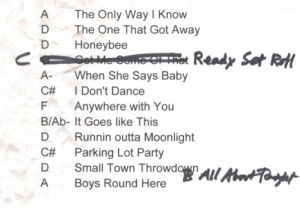 There’s a really unique aspect to a Peach Pickers show. We play songs that are the most successful chart-toppers of modern-day country radio, songs written by these three guys, yet made famous by others. So the crowd knows our tunes, yet most have never heard them performed by the original writers. A Peach Pickers performance is very organic, powerful, sometimes rough around the edges, and performed by what many in Nashville would consider a “stripped down band”. Most of the radio versions of our songs feature multi-tracked guitars, layers of fiddle, steel, keyboards, background vocals, etc, and most touring bands that play behind country artists consist of this instrumentation. Our group is basically like a traditional rock band – drums, bass, and two electric guitars. Nothing against modern day radio production, but I find that this stripped down approach allows us to rock a little harder while allowing the essence of the song to shine through without obstruction.
There’s a really unique aspect to a Peach Pickers show. We play songs that are the most successful chart-toppers of modern-day country radio, songs written by these three guys, yet made famous by others. So the crowd knows our tunes, yet most have never heard them performed by the original writers. A Peach Pickers performance is very organic, powerful, sometimes rough around the edges, and performed by what many in Nashville would consider a “stripped down band”. Most of the radio versions of our songs feature multi-tracked guitars, layers of fiddle, steel, keyboards, background vocals, etc, and most touring bands that play behind country artists consist of this instrumentation. Our group is basically like a traditional rock band – drums, bass, and two electric guitars. Nothing against modern day radio production, but I find that this stripped down approach allows us to rock a little harder while allowing the essence of the song to shine through without obstruction.
While Rhett has had success and experience on the big stage, Ben and Dallas are newer to this forum, yet they rise to the occasion every time, perhaps with an excitement and enthusiasm that would be impossible to have in any other scenario. Together, the three of them make a formidable team. It probably doesn’t hurt that the rest of our band is made up of some extremely talented folks – Nick Forchione on drums and former G-men, Mike Chapman on bass and Chris Leuzinger on electric guitar. I’m extremely proud of this band, were all friends, we love playing music together, and we make it happen every time.
The farm tour might be over, but the memories are forever. Luke’s entire crew, band, and management treated us with great care and respect, which speaks volumes of the man himself. We all made some new friends and strengthened the bonds between old ones, and I sure hope we get to do it again next year! In the meantime, The Peach Pickers might just have a few more surprises for you, stay tuned!
Click to view a slideshow of many more images from the shows.
By Eric Normand
I recently read an article on Huffington Post, “Art and Music Are Professions Worth Fighting for, and while I agree with some points of this article I think the author does a major disservice in presenting the pursuit of music as a profession in a kind of “all or nothing” approach. He talks about a presentation he made at a high school career day where he suggests music as a possible career choice for young people. He says that those interested should “go for it, with abandon and furious joy, and that you do so without a plan B”. This is where I disagree. I also disagree with the distinction this makes between “career musicians” and nonprofessional musicians. Just because you don’t play professionally doesn’t mean your music isn’t valid. I agree, if you love music and want to pursue it, why not pursue it wholeheartedly, but what’s the matter with pursuing music while earning a living from something else? What’s the matter with pursuing music for the mere enjoyment of it? I believe you can pursue music as a career and for fun, but you need to keep your eyes open and realize that you will need a steady income stream along the way. To decide how music or a music career might fit into your life, perhaps the questions you really need to ask yourself are; why are you pursuing music, what do you want to get out of it, and what will it take to be successful? What is your definition of success?
When I was a senior in high school, if you had asked me what I wanted to be when I grew up I would have said, “a professional musician”. Immediately after high school I got a job as an apprentice drywall carpenter before enrolling in the Berklee College of Music two years later. After Berklee I played professionally in nightclub bands for the next 14 years, eventually also becoming a guitar teacher. In 2002 I relocated to Nashville Tennessee where I’ve had the good fortune to work as a hired gun on several major tours. My first gig was as a guitar tech for Toby Keith, and I went on to play lead guitar with several country artists – Daryle Singletary, Vern Gosdin, Rhett Akins, and the hit songwriting team known as “The Peach Pickers”, among others. I also wrote a book about how to navigate the Nashville music industry, “The Nashville Musician’s Survival Guide”.
Looking back, if you had told that starry-eyed high school kid that one day he would be a musician, painter, drywall carpenter, teacher, author, and website designer, he would’ve said “Naw, I’m not interested in any of that other stuff”. But as they say “life is what happens while you’re busy making other plans”, and one of the things I’ve learned along the way is that you have to wear a lot of hats to survive in this world. The truth is, my original goal of being a professional musician was based on the glamorization of the musical era that I fell in love with, and I had no idea about the reality of any of it.
What do professional musicians do?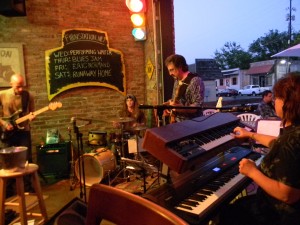
We starve! Just kidding (well, not entirely). The options for musicians trying to earn a living from their craft are somewhat limited. The way I see it you can pursue one or more of the following avenues; nightclub musician, music teacher, touring musician, or session musician. Sure, there are other gigs (orchestra musicians, jingle writing, etc.) but these four are the most practical, and out of these, the first two are the only ones that ever become reality for most. If you want to be a touring or session musician, you will need to live in a music metropolis such as Nashville, New York, or LA, and these are extremely hard (but not impossible) gigs to land.
Regarding paying gigs, I’m talking about work you can get on a regular basis that pays real money for your services. Therefore, I’m leaving out songwriters and aspiring artists because these do not pay any real money unless you become extremely successful. TV shows like “American Idol” and “The Voice” have propelled the myth that anybody that learns how to sing a good cover song can become a national recording artist and superstar. Out of the tens of thousands who audition for these shows and the hundreds that perform on them annually, how many are ever heard from again?
While I cherish many of my experiences as a professional musician, I’ve learned the hard way that it doesn’t always pay the bills. Night club gigs still pay what they paid 25 years ago when I first got into this ($100 a night is still considered good pay) and most club gigs in Nashville don’t even pay that. As far as touring musicians, most tours only pay during the part of the year that the tour is active and, unless you are on a very high profile tour, you’ll have to find another income stream during the winter.
 Two years ago, I went back to full-time construction work, and put my music career on part-time status. I began approaching music as simply one component of my life, and for first time since I’ve been in Nashville I’m actually earning a steady living year-round. I still play music, sometimes for pay, always for fun, and I get just as much reward, if not more, out of a local club gig playing for tips as I do when I perform with The Peach Pickers on the Luke Bryan farm tour in front of 15,000 people.
Two years ago, I went back to full-time construction work, and put my music career on part-time status. I began approaching music as simply one component of my life, and for first time since I’ve been in Nashville I’m actually earning a steady living year-round. I still play music, sometimes for pay, always for fun, and I get just as much reward, if not more, out of a local club gig playing for tips as I do when I perform with The Peach Pickers on the Luke Bryan farm tour in front of 15,000 people.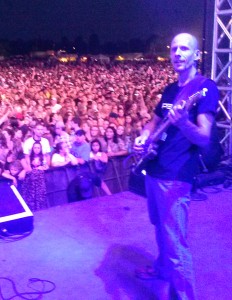
Don’t get me wrong, I’m not here to talk people out of their dreams; after all, I did write a book about surviving the Nashville music industry. But if this is your dream, you need to arm yourself with knowledge and know what you’re up against. If you’re thinking about pursuing music or arts as a profession you must first “define your success”. What is your definition of success in music? Then ask yourself why you want to do this. If it’s because you think it’s an easy and fun way to make a living you might want to do a little more research. It can be fun, but it’s definitely not easy. If it’s because you absolutely can’t see yourself doing anything else, then go for it, but have a plan B, and have a way of earning a living while you pursue it.
There’s nothing wrong with pursuing music as a career, and there’s also nothing wrong with being a musician or artist that never becomes “professional”. Music is one of the oldest forms of communication, music has the power to heal and unite people, and playing music makes you smarter. So go ahead and work at becoming a great musician, it’s a noble thing to do and the world always needs good music and art. Approach your music with abandon and joy, but don’t be afraid to have a plan B.
Follow Eric on Twitter and his blog at survivenashville.com
By Eric Normand
You might think that the life of a touring musician is easy – performing for thousands of screaming fans, sleeping late, eating at catering, free booze, lounging around all day on a million-dollar tour bus. While some, or all of this might be true depending on what tour you’re on, there are many other factors at play that can make the life of a traveling musician somewhat less than glamorous. Being away from your family, lack of privacy (rarely is there a moment on the road that you are not in the company of others), less than ideal sleeping conditions, and, believe it or not, too much free time, just to name a few. These factors can lead to a slew of problems – fatigue, depression, 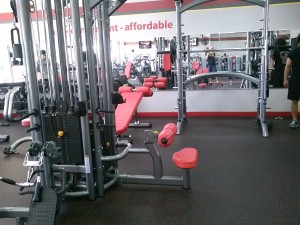 over eating, and overindulgence.
over eating, and overindulgence.
My recent outing with the Peach Pickers as an opening act on the Luke Bryan Farm Tour turned out to be a great experience and (thanks to a few forward thinking folks in Luke’s camp) a successful experiment in healthy living on the road. It turns out that several members from Luke’s band have built a daily gym run into their touring schedule, an activity that is open to the musicians and the opening bands, as well. Every day around 10:30 AM, anywhere between six and ten of us would pile into a runner van for a short ride to a local gym. Once at the gym many of us did our own thing, activities ranging from treadmill to circuit training to stretching and yoga.
Luke’s guitarist and bandleader, Michael Carter explained that “the one thing we do have out here is time” and that working out every day can be more difficult for people who work an eight hour workday with a commute. For many touring musicians, the first requirement of their work day is a sound check, usually sometime in the afternoon, and then the nightly show. Believe it or not, just lying around all day on a bus and watching TV can be tiring (not to mention boring) and this can be very draining. Not only does the morning workout speed up your metabolism and give you added energy for the day, it also temporarily removes you from “diesel city”, giving individuals a chance to have some privacy and clear the head.
Getting Creative:
Even on a tour of this level, working out at a gym can’t happen every single day, sometimes the closest gym is just too far away, a runner isn’t available at the necessary time, etc. When the gym run didn’t happen, we all got creative. On one day we all went for a run. On another day, when running wasn’t practical due to our location, we all found creative ways to get in a workout. Michael did a modified version of “Insanity” in the back of a semi trailer, a few members of Cole Swindell’s band (one of the other openers) played power frisbee, a few did some circuit training, and I did some yoga in a quiet corner of the field.
Healthy Eating:
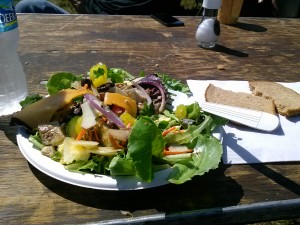 While the issue of what is, and what is not healthy food is still a mystery to many in Western culture, and it can be a touchy topic yielding much debate for some, I am going to go out on a limb here – healthy food is food that allows me to feel good after I eat it, unhealthy food is food that makes me feel crappy after I eat it! That being said, my diet typically consists of fresh fruits and vegetables, whole grains, nuts, healthy oils, and protein derived from poultry and fish (preferably raised in a healthy and sustainable environment) – and as you might guess, this kind of food isn’t always easy to find on the road. So you can imagine how pleased I was to find that the catering on this year’s Farm Tour featured a pretty happenin’ salad bar. Every day my lunch and dinner consisted of a big plate of mixed greens, carrots, mushrooms, cherry tomatoes, hard-boiled egg, grilled chicken, and topped with olive oil and balsamic vinegar. I noticed that several of the other musicians on this tour made similar meals. On days when the main entrée was chicken and/or fish, and I would have this in addition to my salad for dinner. For breakfast, I was typically having a couple of eggs, some whole wheat toast, and a bowl of fruit.
While the issue of what is, and what is not healthy food is still a mystery to many in Western culture, and it can be a touchy topic yielding much debate for some, I am going to go out on a limb here – healthy food is food that allows me to feel good after I eat it, unhealthy food is food that makes me feel crappy after I eat it! That being said, my diet typically consists of fresh fruits and vegetables, whole grains, nuts, healthy oils, and protein derived from poultry and fish (preferably raised in a healthy and sustainable environment) – and as you might guess, this kind of food isn’t always easy to find on the road. So you can imagine how pleased I was to find that the catering on this year’s Farm Tour featured a pretty happenin’ salad bar. Every day my lunch and dinner consisted of a big plate of mixed greens, carrots, mushrooms, cherry tomatoes, hard-boiled egg, grilled chicken, and topped with olive oil and balsamic vinegar. I noticed that several of the other musicians on this tour made similar meals. On days when the main entrée was chicken and/or fish, and I would have this in addition to my salad for dinner. For breakfast, I was typically having a couple of eggs, some whole wheat toast, and a bowl of fruit.
To me, healthy eating on the road is all about choices and discipline. On this tour, there were many healthy options, and there were also unhealthy options. I’ve been on other tours that didn’t have catering with this many options, in those situations I often brought more of my own food. I generally steered clear of the “after show” food, which typically consisted of pizza, fried chicken, sandwiches on white bread, etc; and chose to eat almonds, corn chips and salsa, and of course, the occasional indulgence (it’s all about balance).
Building Community:
Taking advantage of my free time, I worked out every single day on this eight-show run across the Deep South. In addition to taking care of my body and helping me feel good, working out with members of Luke’s and Cole’s bands also helped create a sense of community. The more and more I get into healthy living, the more I want to align myself with others who are on the same path, and I instantly felt some common ground with the “2013 Farm Tour Gym Crew”. It was inspiring to be on a tour that gives musicians the option to have a daily workout, and a relatively healthy meal.
Healthy living isn’t just for a few oddball touring musicians.
So what if you work a day gig and don’t have as many idle hours during your day? Funny you should ask. In recent years my life as a touring musician has greatly diminished, and much of the time I’ve been holding down a steady day gig as a painter and drywall carpenter (something I’ve done on and off since high school). This job is very physically demanding, and if I don’t take care of myself, I am susceptible to shoulder aches, back pain, tendinitis flareups, and a whole host of other problems. Working out and healthy eating combats these problems. As far as daily workouts, I find that if I don’t do something first thing in the morning I might not get in any workout on that day. Knowing this, I make it a priority to do at least 30 minutes of exercise before leaving for work in the morning. I prepare my lunch the night before, usually consisting of leftovers from a healthy dinner, almonds, fruit, green tea and water.
I look at all of this as a choice. In addition to advanced planning, healthy eating simply requires a conscious decision to buy, prepare and eat healthy foods. The same is true for exercise, as I age, things hurt more, and the recovery time from injuries is longer. Rather than looking for answers within Western medicine, I choose a steady regiment of cardio, strength, and flexibility exercises (in addition to my healthy diet). I believe there is a healthy way to prepare all your favorite foods. And I believe that each individual has to find an exercise program that is right for them.
For more information about wellness through exercise and healthy eating, please visit http://www.doitthehardway.com/
